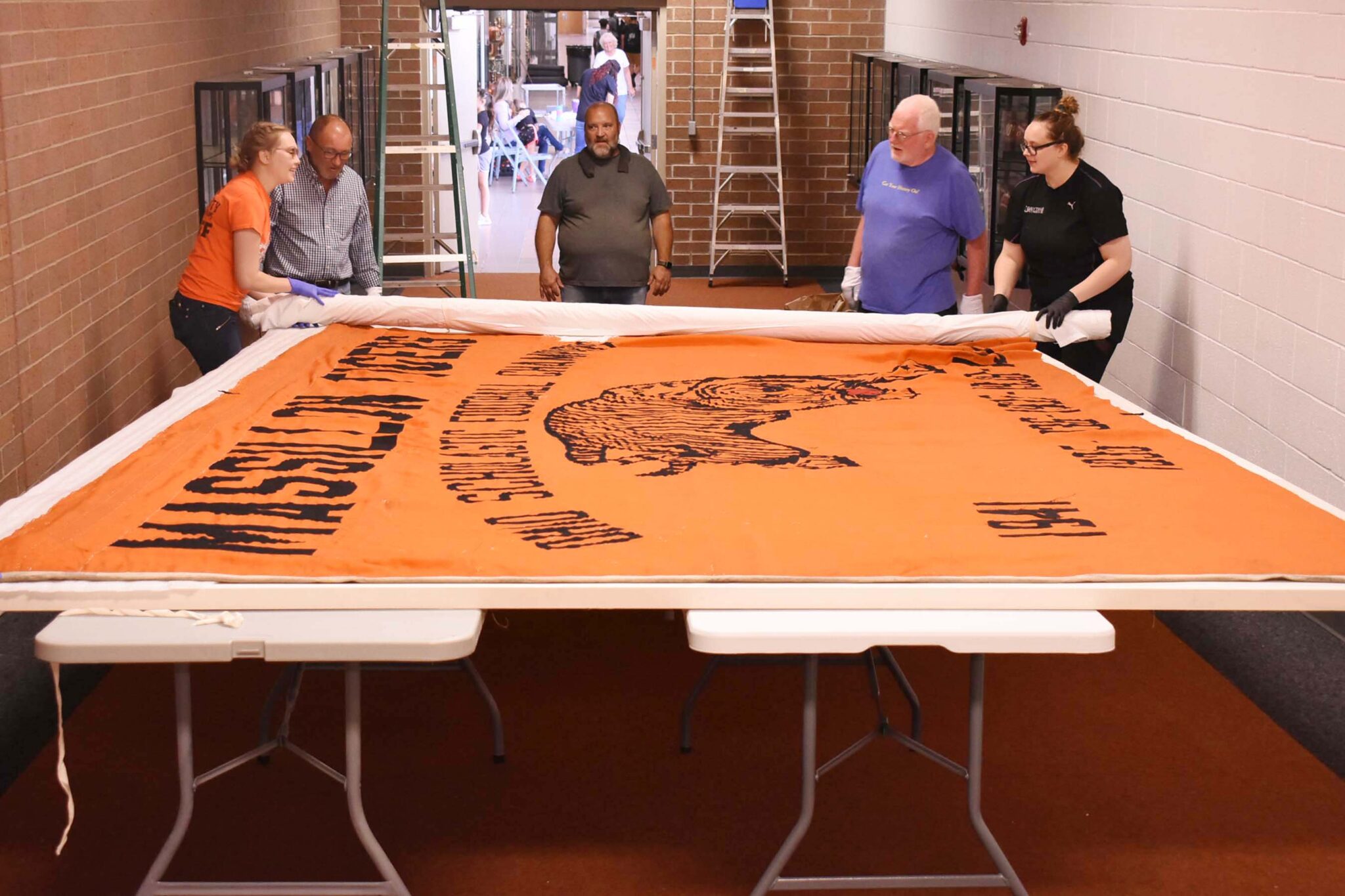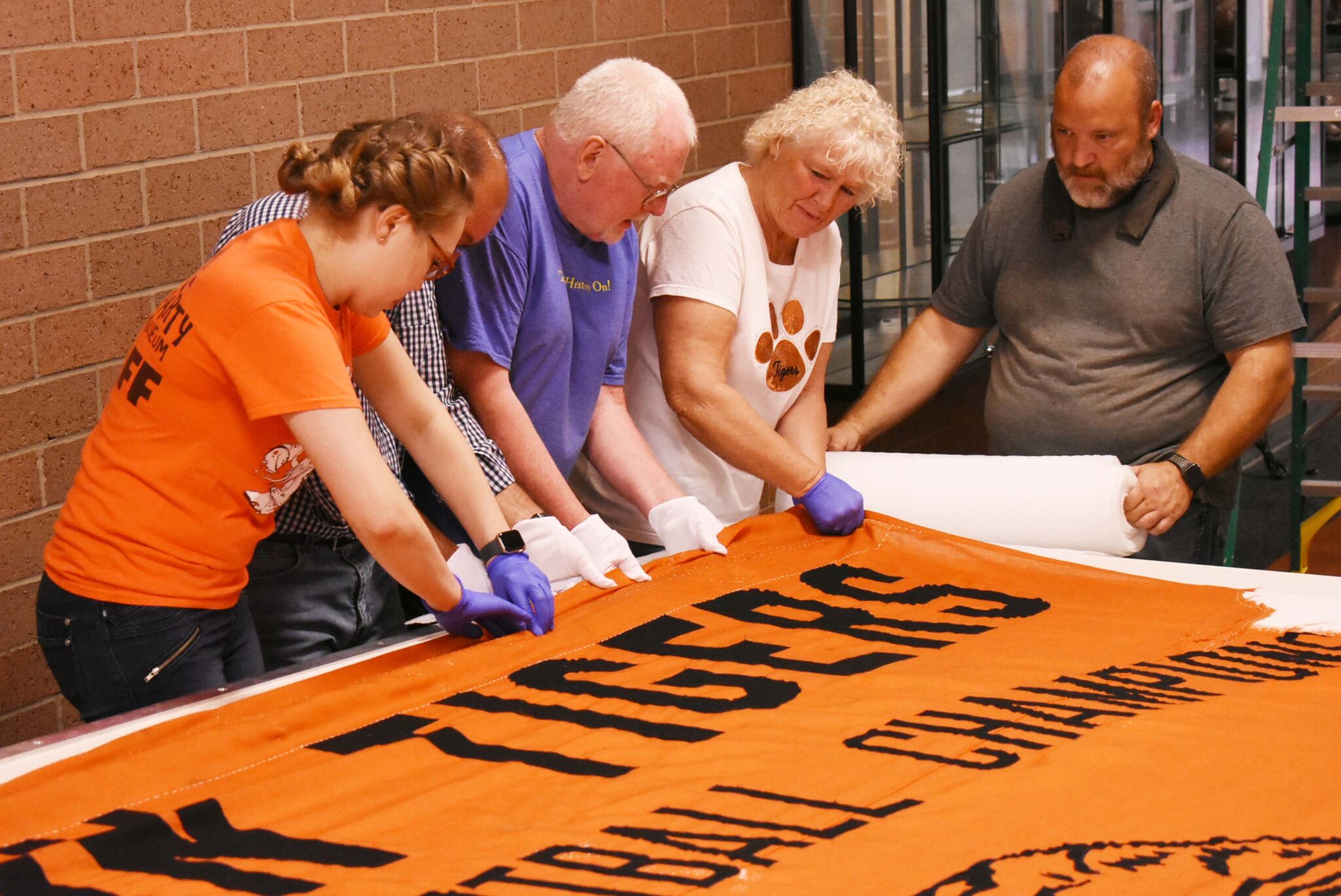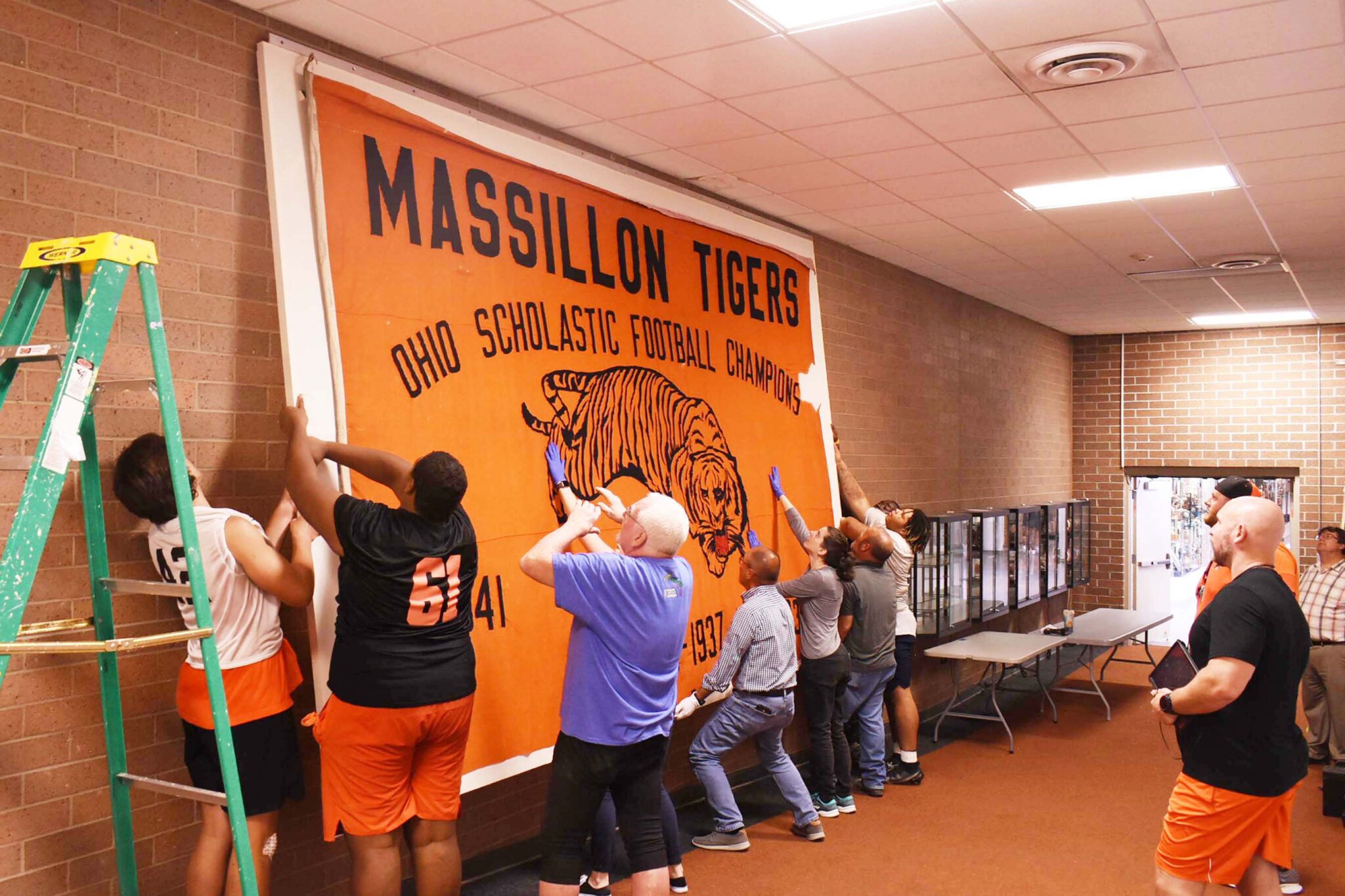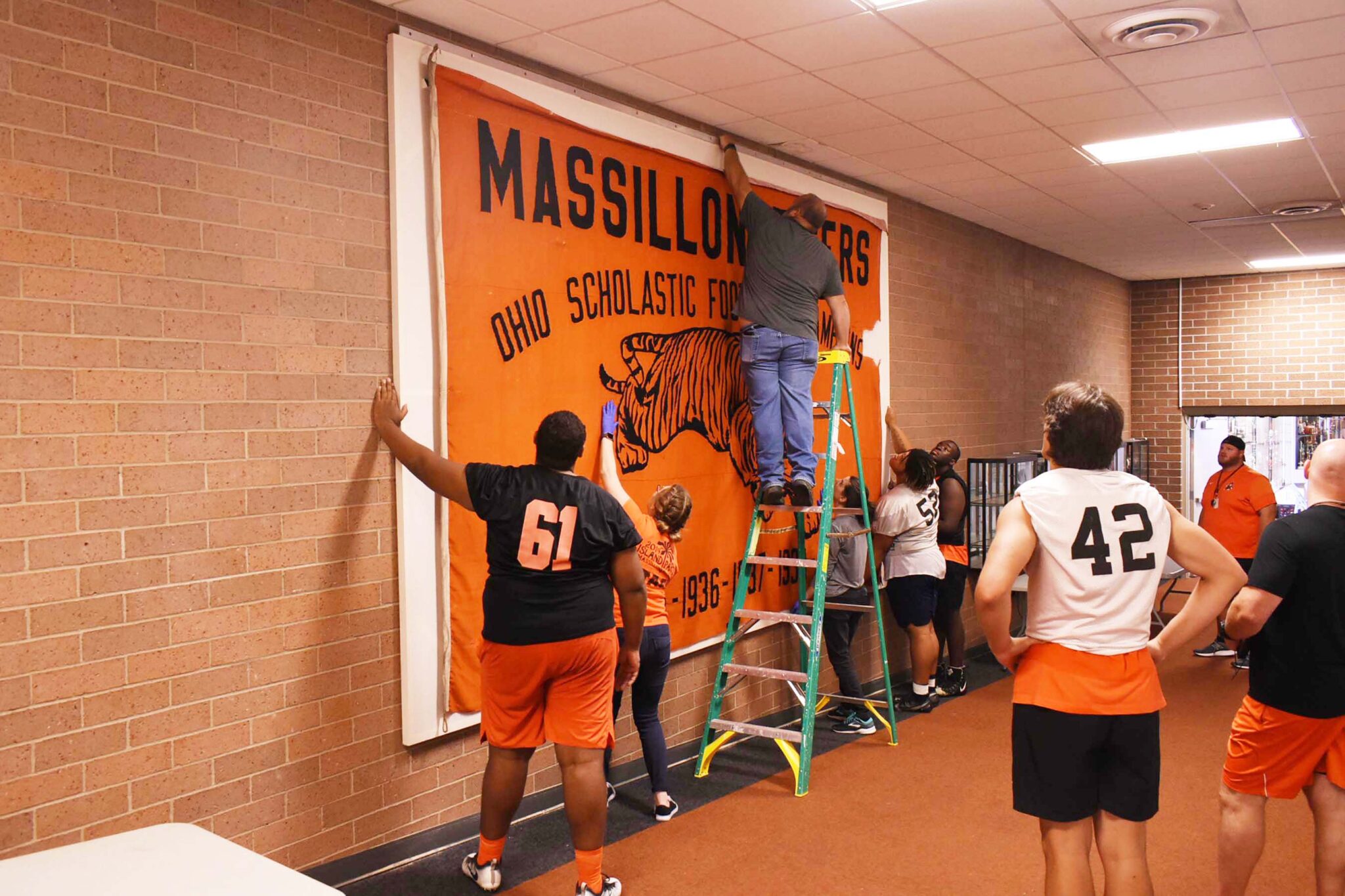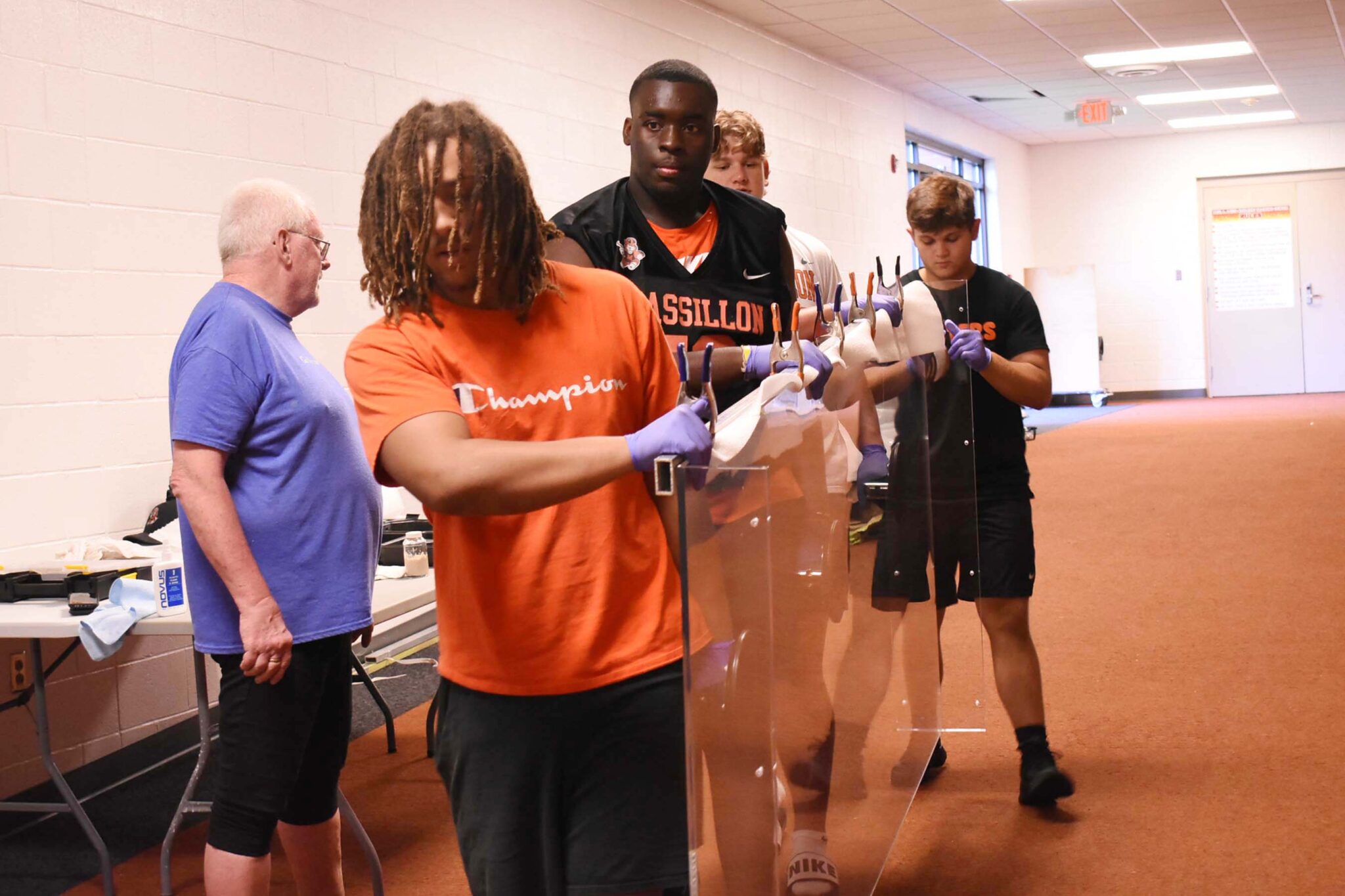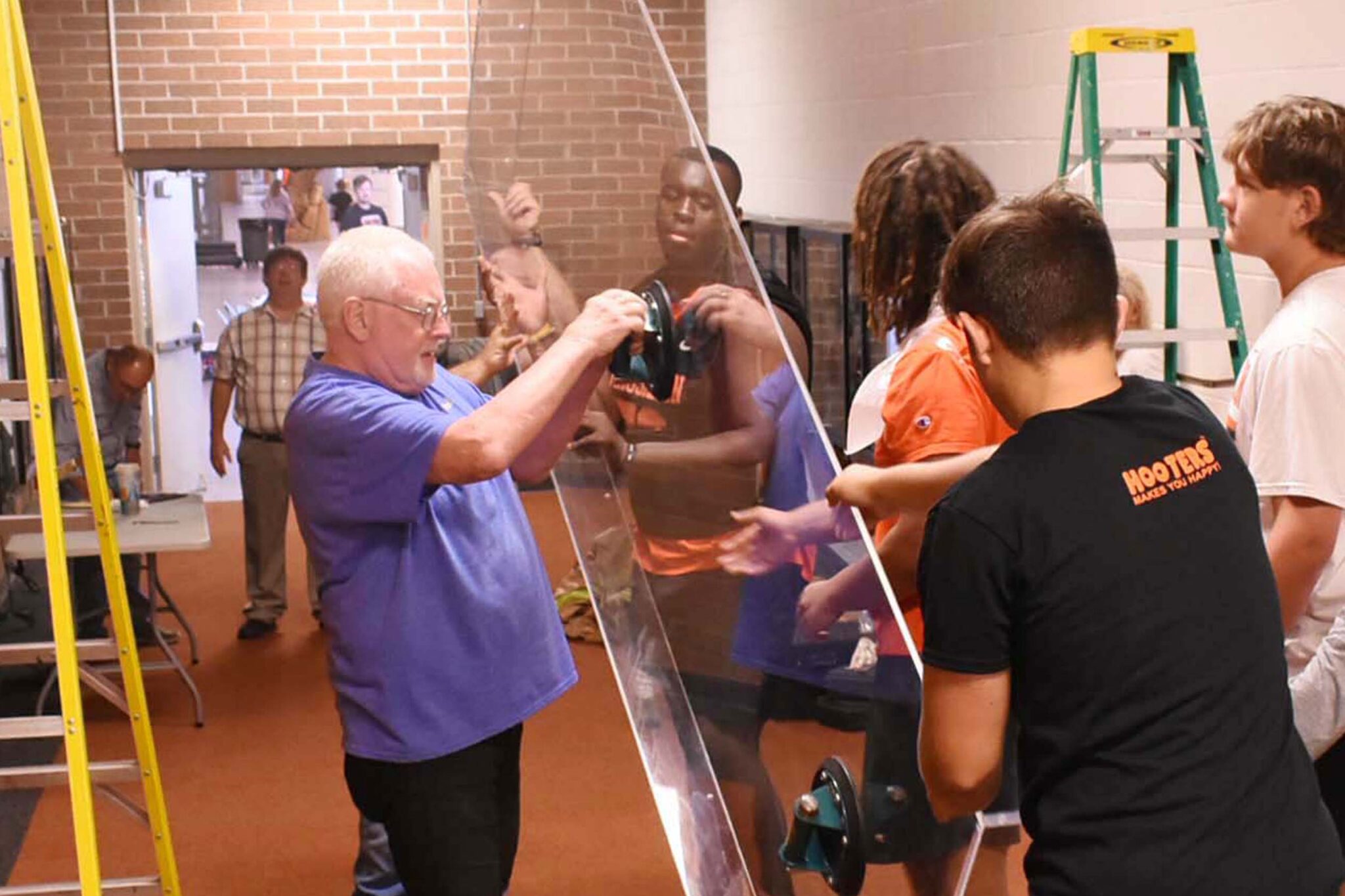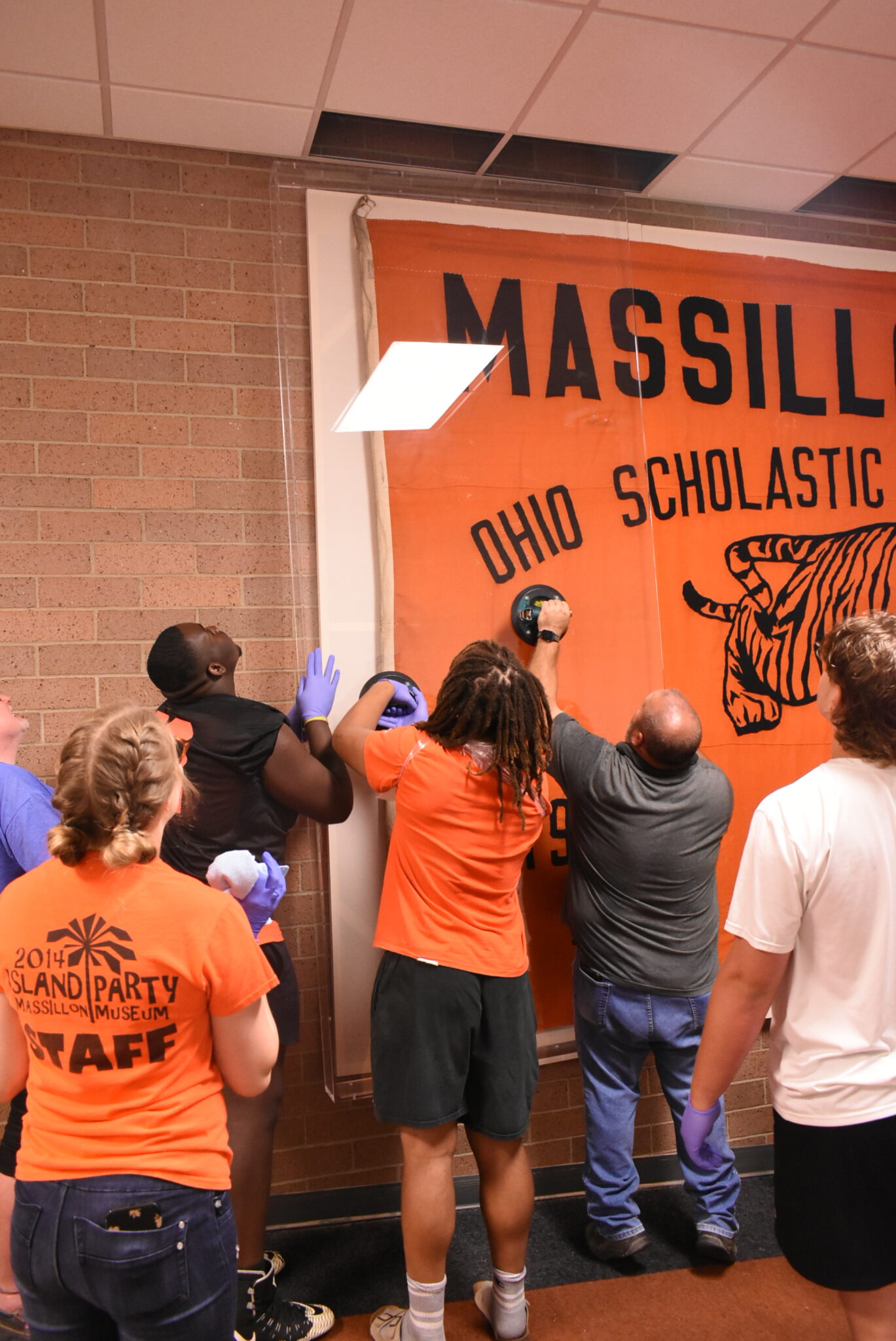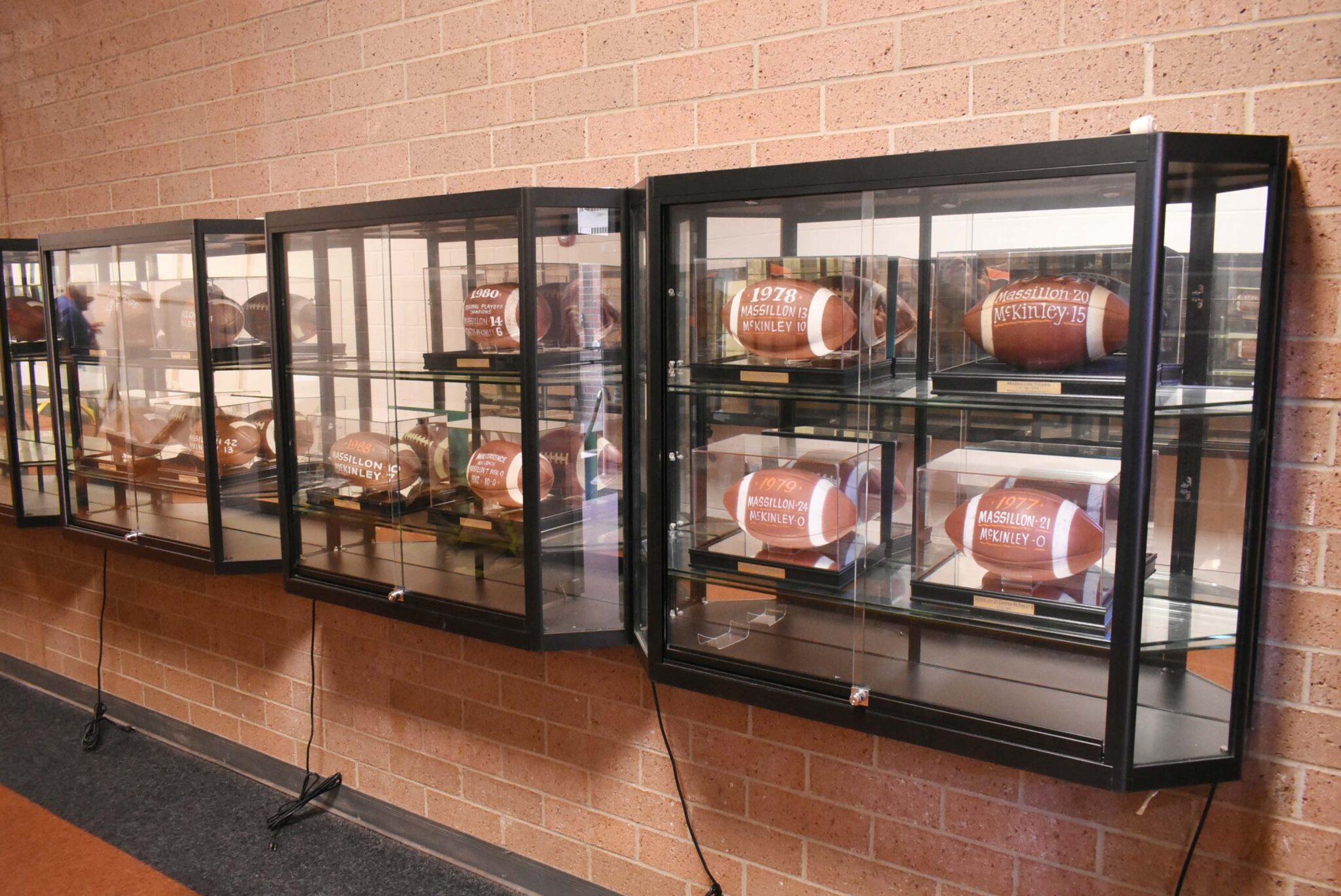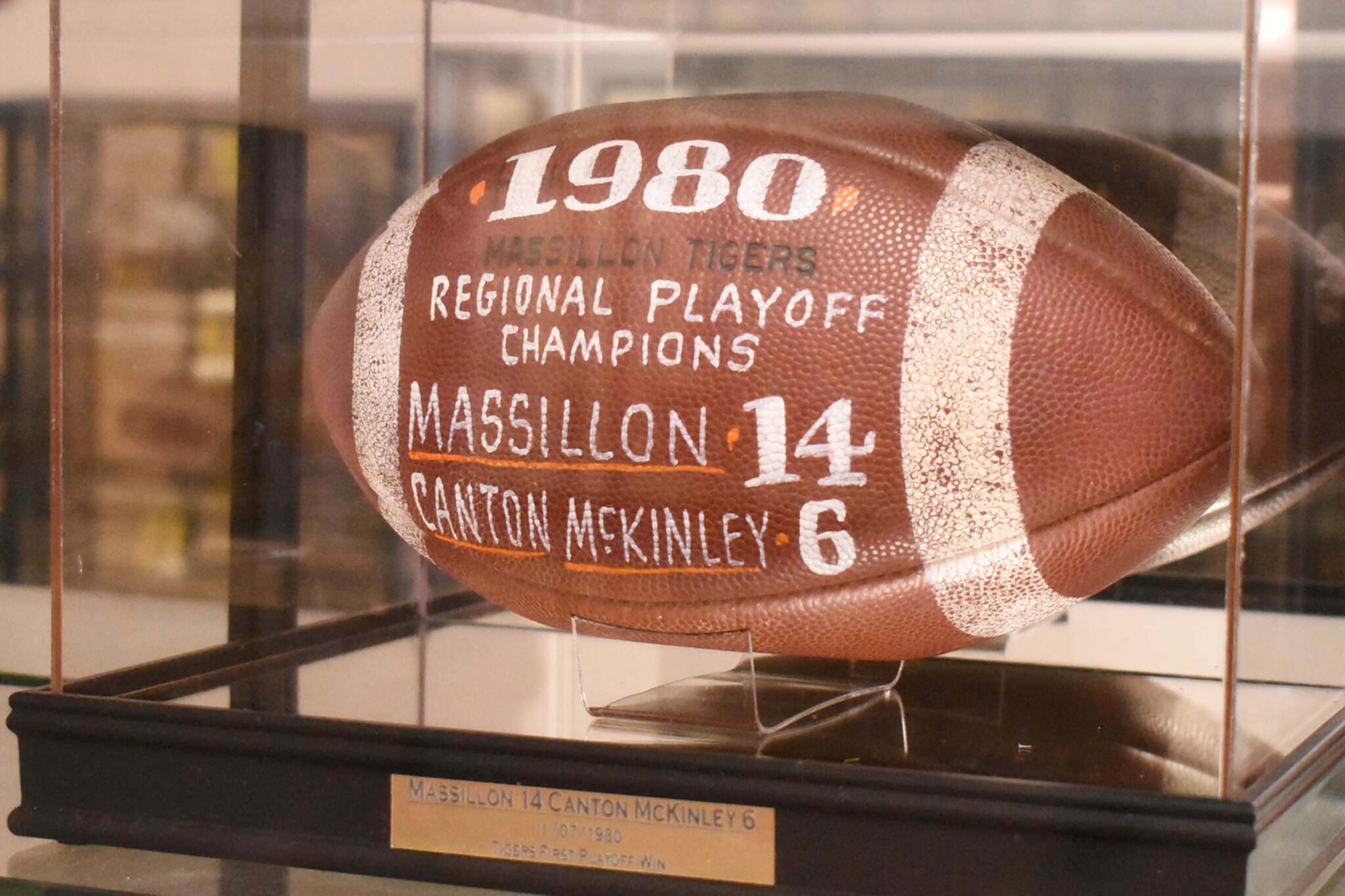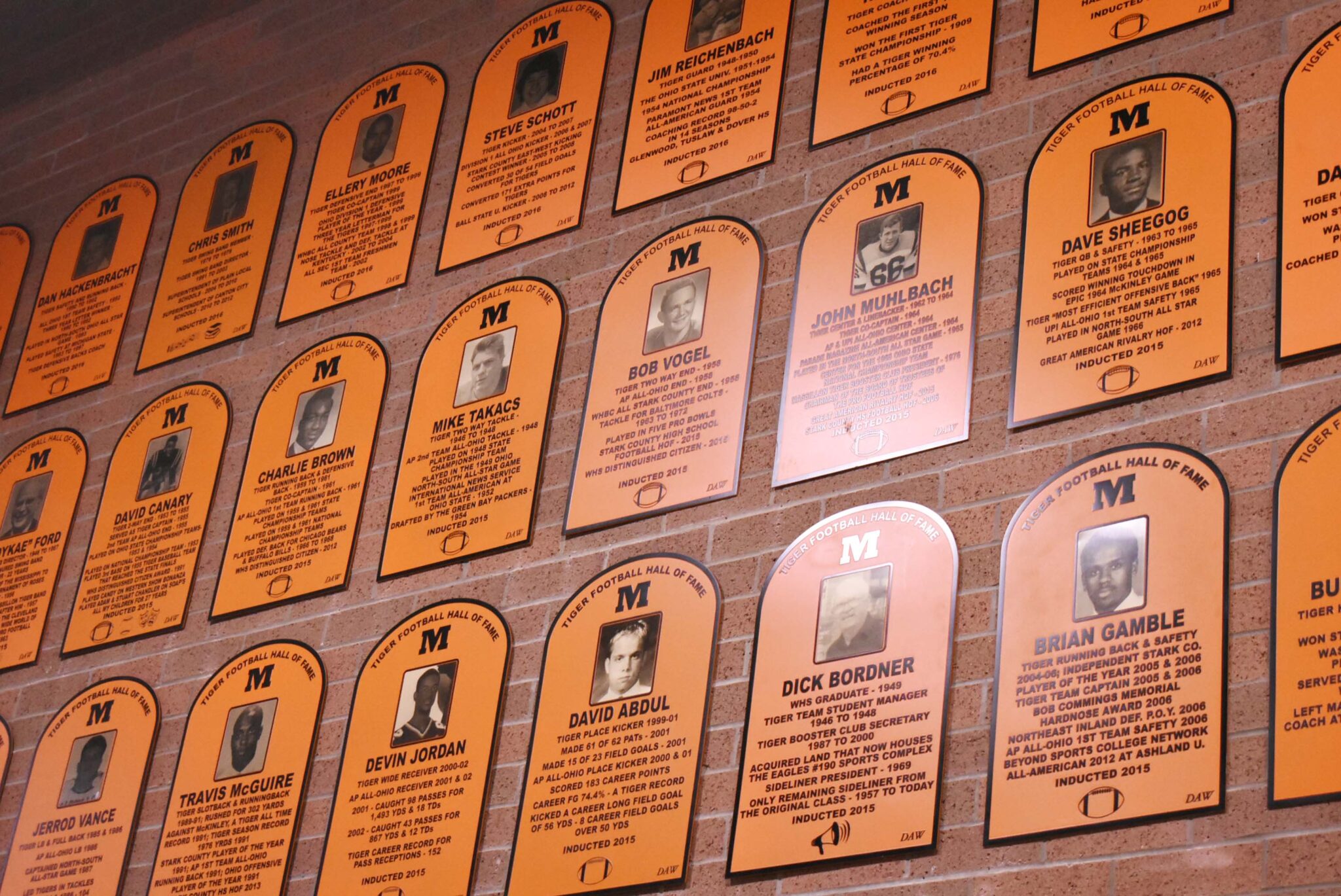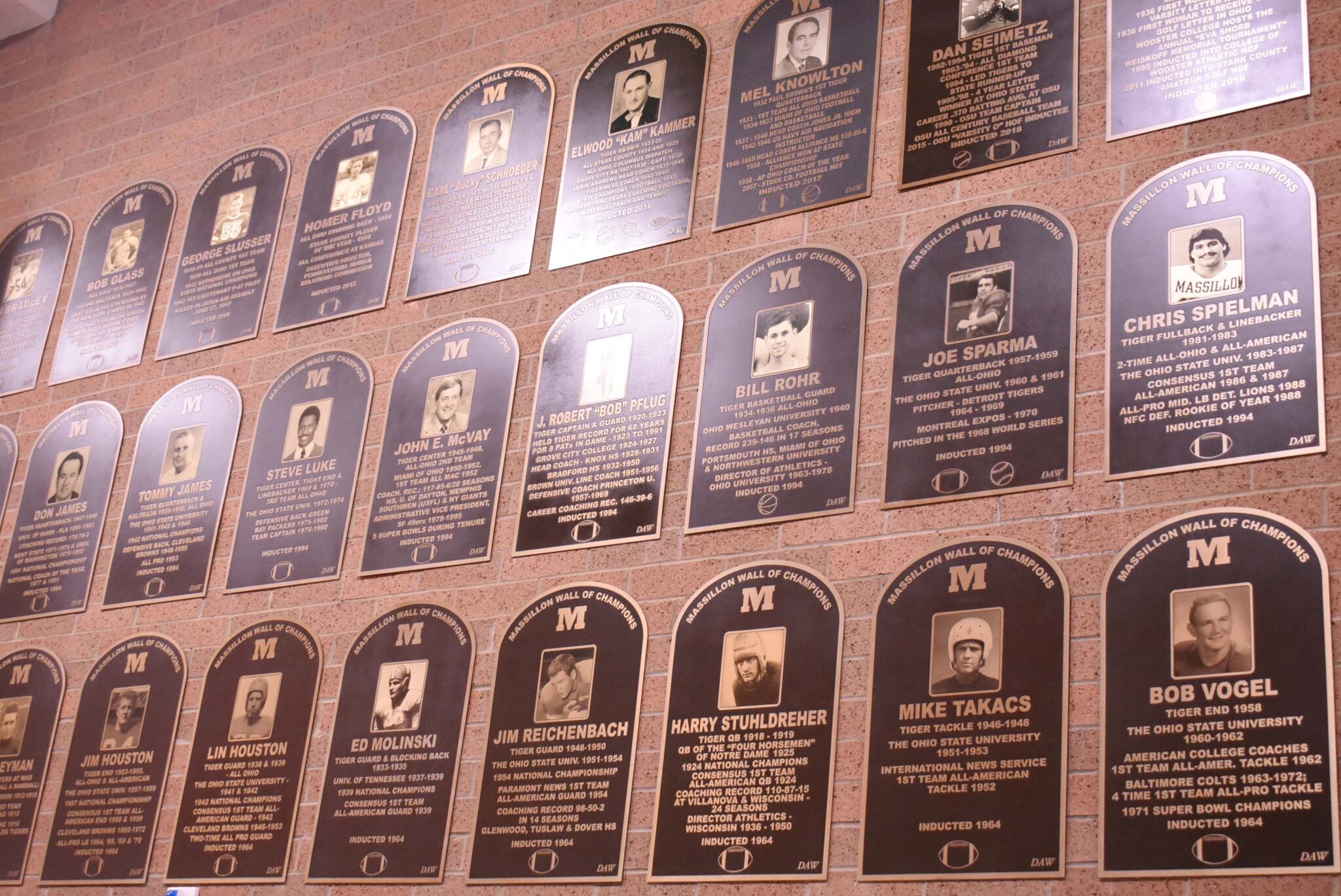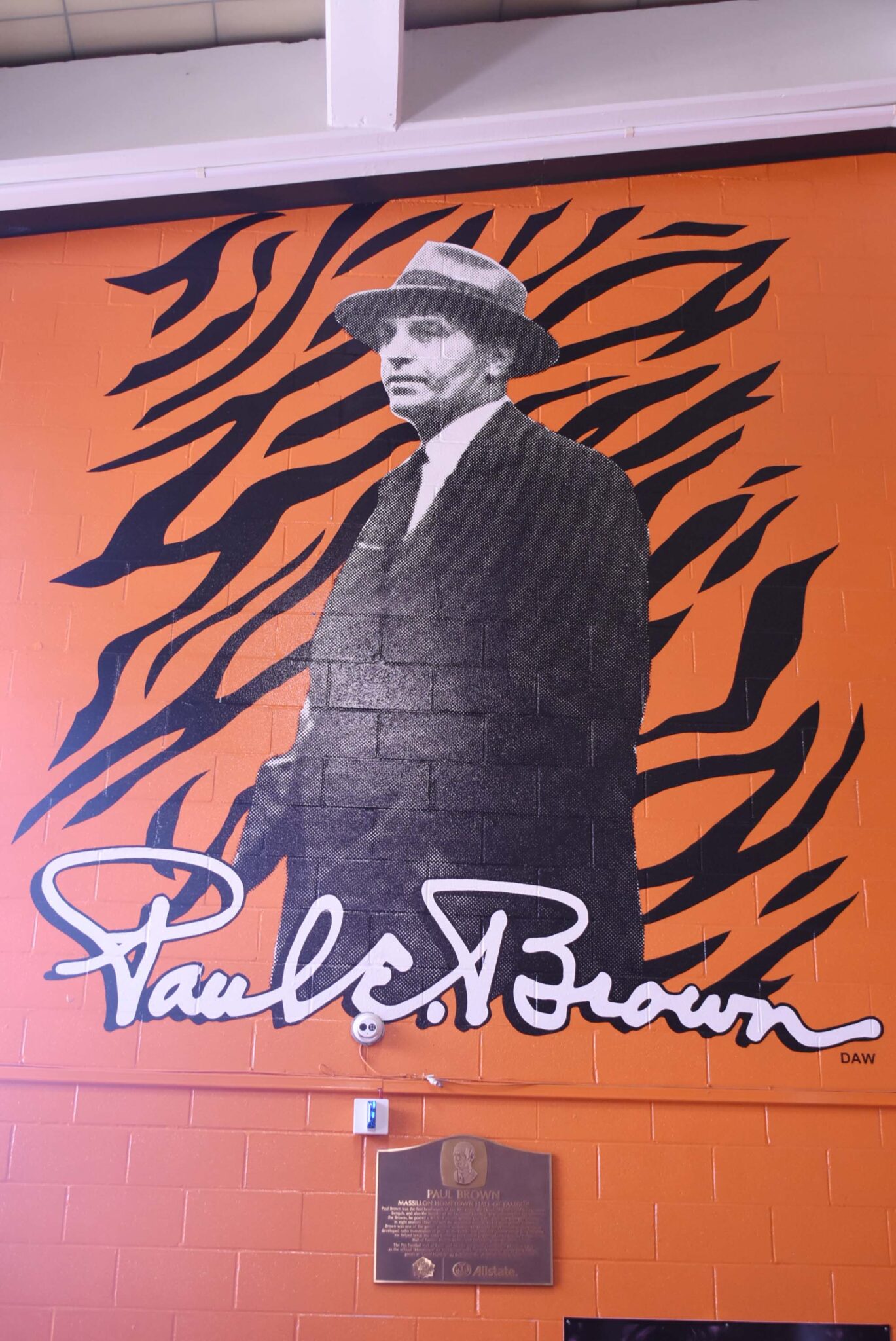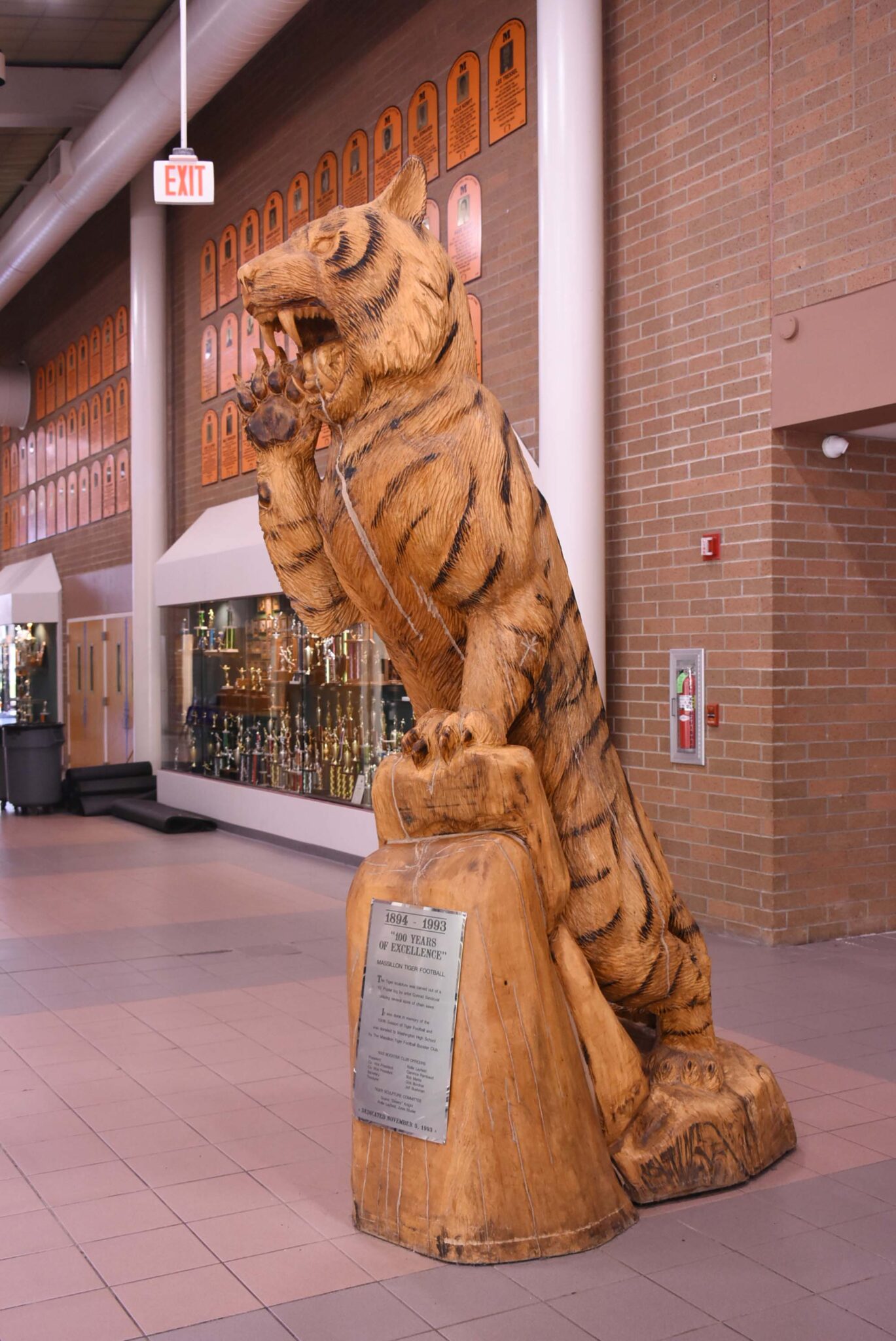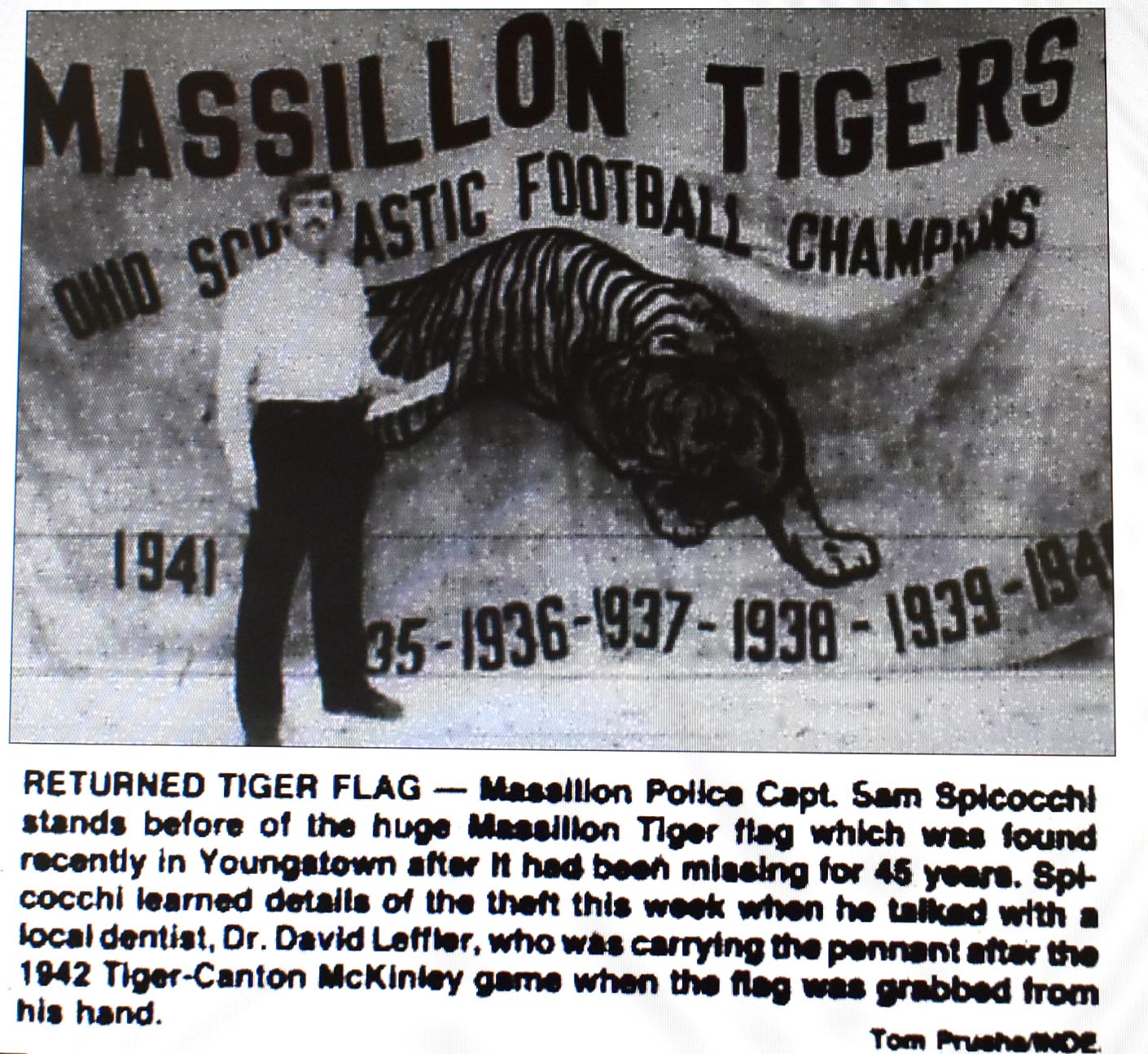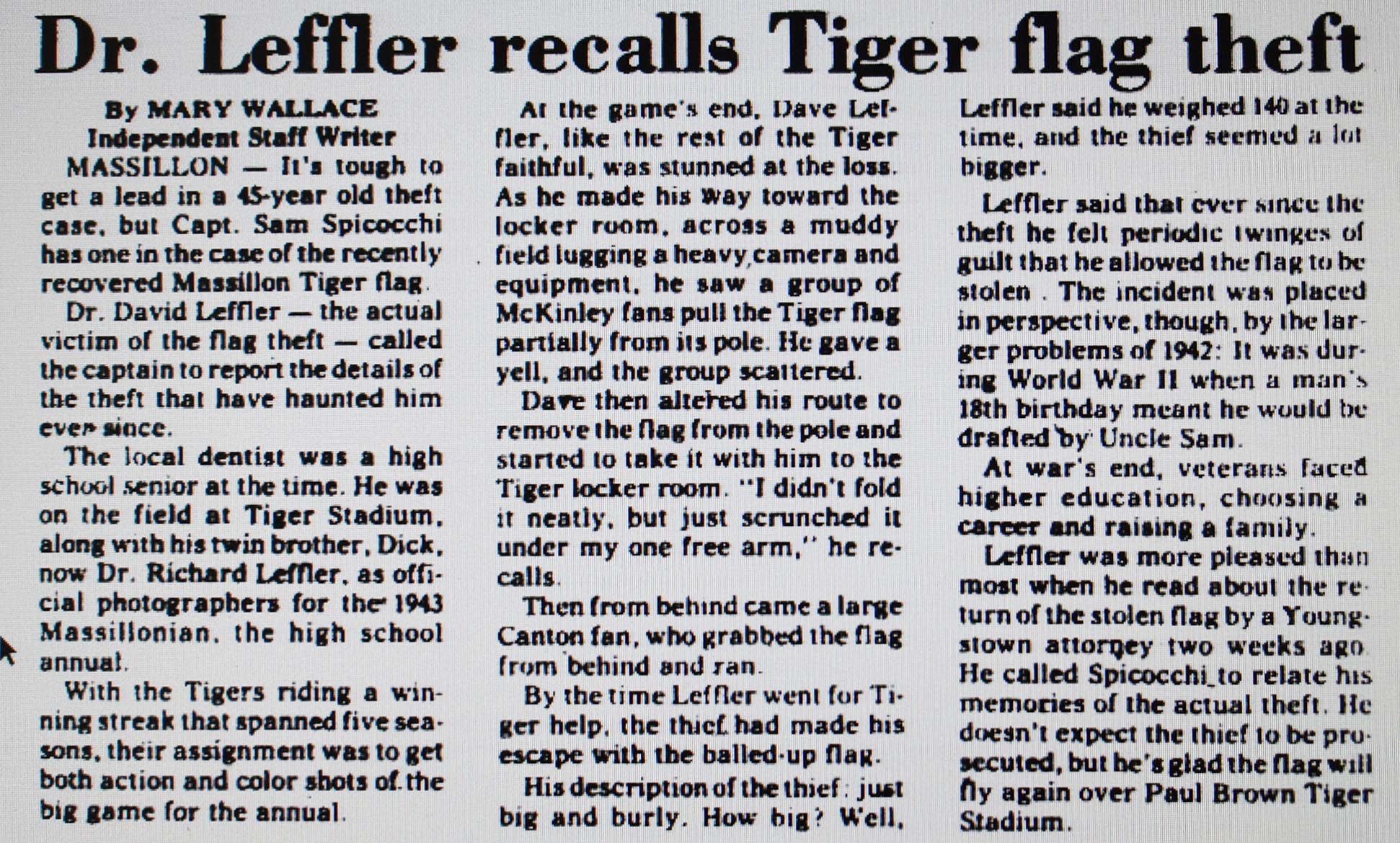 History
History Thank You Fireworks Sponsors for 2021

 History
History 
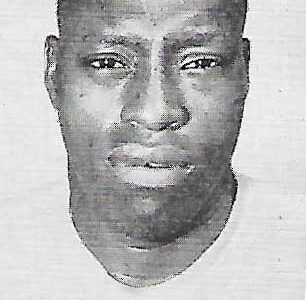 History
History As a football player, Bobby Grier had a conventional career for one of the Massillon’s better players, starting for Tigers during his senior season and then playing collegiately. But in 1955 civil rights discrimination in the South reared an ugly head and Bobby, as a Black player for a Northern team, was caught in the middle. But he along with his teammates handled it admirably. And now Bobby is finally being honored by Massillon with a spot on the Wall of Champions.
Bobby Grier suited up for the Tigers from 1949-51, playing fullback and safety under successful head coach Chuck Mather. During his junior year Massillon finished the season with a perfect 10-0 record and was named both INS state champion and national champion. The Tigers were completely dominant in all ten games, outscoring their opposition 407-37. The only team to score more than once on them was No. 8 Steubenville, which lost 35-12. In the season finale the Tigers downed No. 9 Canton McKinley 33-0. As a backup, Grier contributed five rushing touchdowns.
In 1951, the 190 lb. senior player started at halfback was instrumental in leading his team to a 9-1 record and an INS state championship, in spite of suffering a 19-13 setback to No. 7 Warren Harding. Since there were no 10-0 teams in the state of note that year and the Tigers had defeated both No. 2 Steubenville and No. 6 Barberton, plus the fact that they were defending state champs, the crown went to Massillon. Numbers-wise, they outscored their opponents 316-65.
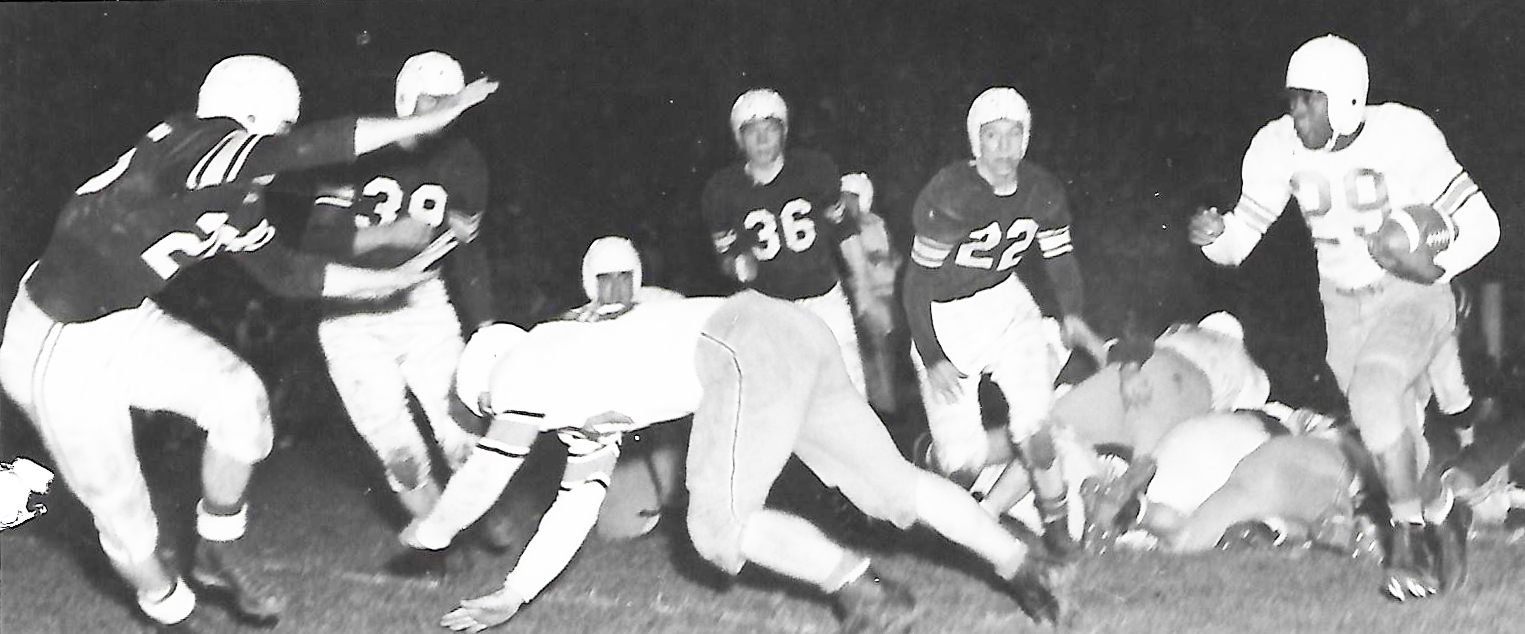
Grier was teammates with several other outstanding players, such as Henry “Ace” Grooms, Tom Straughn, Chuck Vliet and Paul Francisco. He was also tops on the team with eleven rushing touchdowns, ahead of Grooms, who had ten, and John Francisco, who had eight. Against Steubenville he rushed 9 times for 49 yards and scored the game-winning TD. Then against Barberton he scored the only touchdown in a 6-0 victory. For his efforts he was named 2nd team All-Ohio Scholastic League and earned a Division 1 scholarship to the University of Pittsburgh.
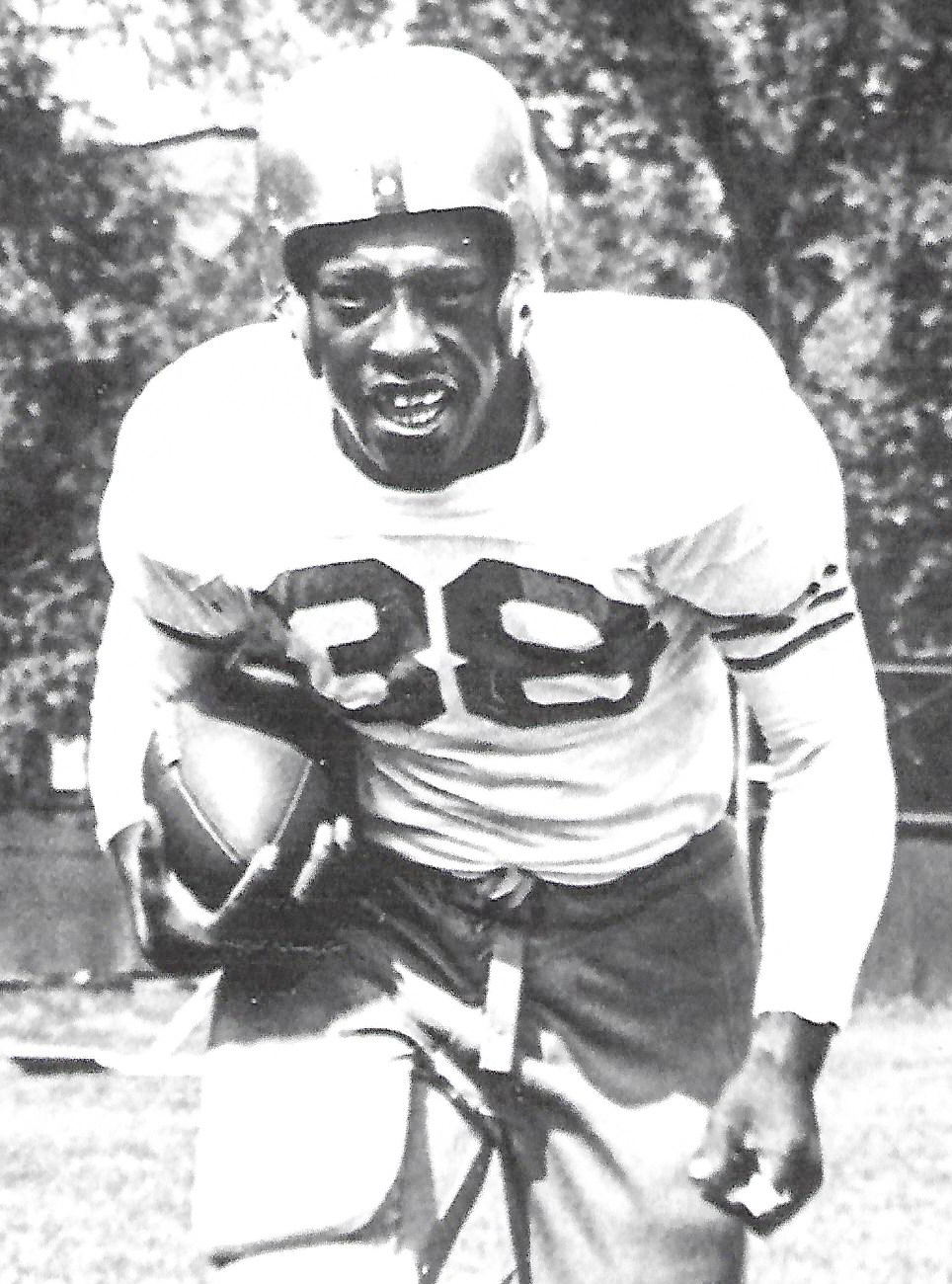 Typical of most college players, Grier worked his way through a talented roster striving for playing time. As a sophomore he rushed 13 times for 198 yards. But his coach was not sold on his defense at a time when players were required to play both ways. Then in 1955, under Coach John Michelosen, Grier started the first game. But he shared time the rest of the season.
Typical of most college players, Grier worked his way through a talented roster striving for playing time. As a sophomore he rushed 13 times for 198 yards. But his coach was not sold on his defense at a time when players were required to play both ways. Then in 1955, under Coach John Michelosen, Grier started the first game. But he shared time the rest of the season.
Fortunately, he was a member of a very good Panther team that finished the year No. 11 in the country and was invited to participate in the 1956 Sugar Bowl in New Orleans, Louisiana. The bowl committee had their eye on West Virginia, but in the final game of the season Pittsburgh defeated the Mountaineers 27-6 and the committee elected instead to invite Pitt. Their opponent would be Georgia Tech. And it was with Tech that the problems began.
Discrimination in the South was alive and well in the 1950s and a Southern team playing in a game against Black opponent players was frowned upon. But the fact that the Black Bobby Grier was a member of the Pittsburgh team was overlooked by the bowl committee since Grier was not a starter and was not expected to play.
That didn’t keep Georgia Governor Marvin Griffin from urging Tech not to participate unless Grier was banned, which irked most of the country, more so than the Rosa Parks bus incident. But what Griffin didn’t expect was 2,000 Tech students rioting at the governor’s house demanding that he rescind the request, while hanging the governor “in effigy.” Even students from the University of Georgia supported Tech. The bottom line was that the Tech students wanted their team to play in the Sugar Bowl, discrimination be damned.
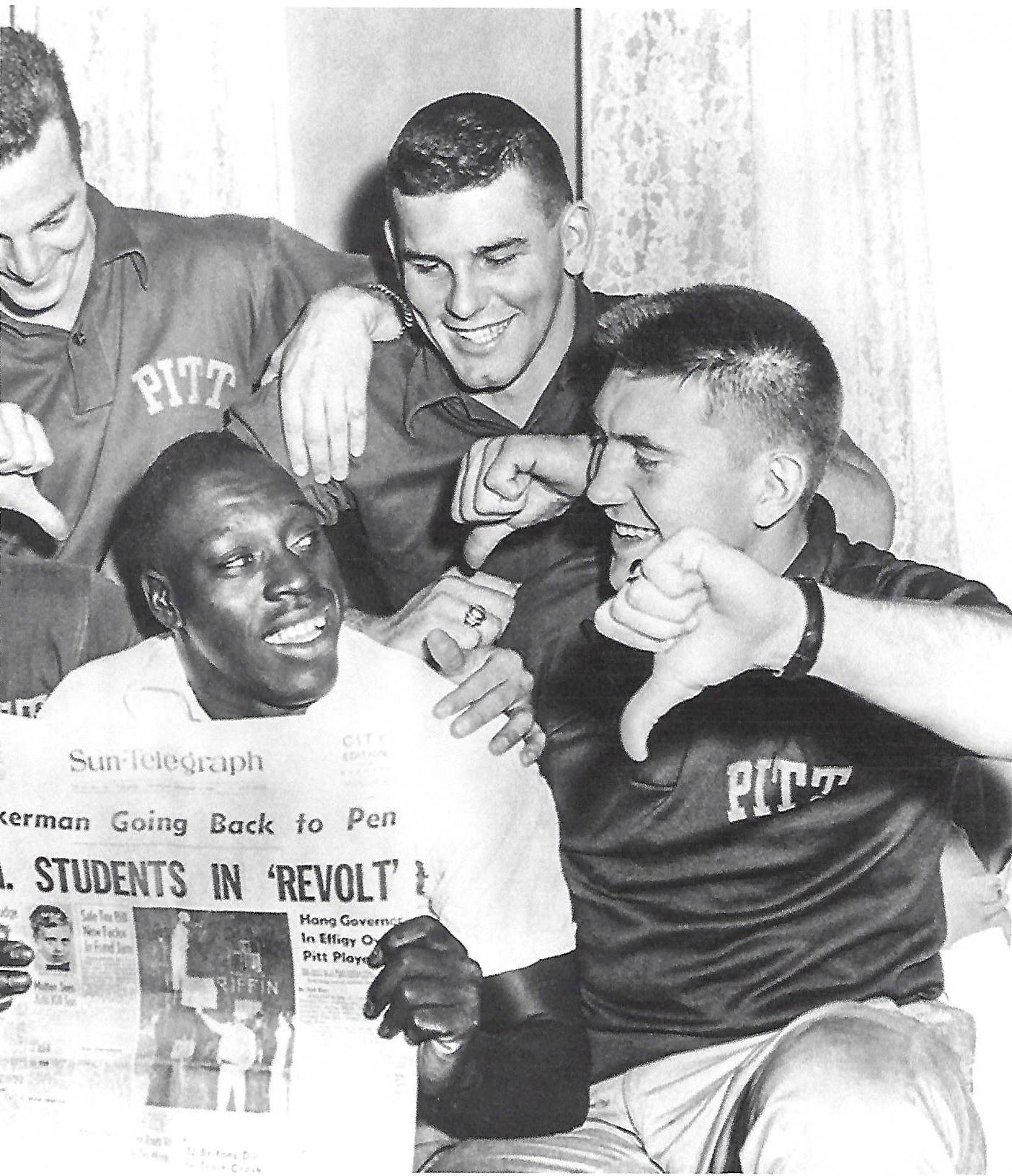 Back in Pittsburgh, the players voted to stay home if Grier was not permitted to play. “It made me feel great that the team, the university and everybody was behind me,” said Grier.
Back in Pittsburgh, the players voted to stay home if Grier was not permitted to play. “It made me feel great that the team, the university and everybody was behind me,” said Grier.
Eventually, the governor’s request was rejected by the Georgia State Board of Regents by a vote of 13-1. First off, the contract had already been signed and second, they really wanted Tech in the game. But still the board created a policy barring Georgia and Tech from playing integrated teams in future games, before integrated crowds, in segregated states, a ruling which seemed to appease the governor. Only the policy was never enforced.
That brings us back to Bobby. As luck would have it, the Pitt starting halfback was injured during a practice prior to the game and Grier was quickly thrust into the lineup. So the game was held and everyone survived, with Blacks and Whites sitting together without incident. But in the end, Bobby Grier became the first Black player to participate in a bowl game in the South, the significance of which was not realized until many years later. Overall, the prejudice was a new experience for Grier. “In Massillon, we learned to get along with people,” he said. “We learned to play together as a team and do a good job of it. We had our differences, but we always came together in the end.”
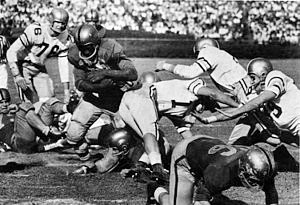 Although Pittsburgh lost the game 7-0, Grier led all rushers with 51 yards. In an ironic twist, Grier was called for pass interference late in the game and the ball was placed at the one yard line, setting up the lone touchdown. Bobby was beside himself later in the locker room. And many thought it was Southern home cooking, noting that Grier was ahead of the receiver on the play and had been pushed to the ground prior to the ball sailing over both of their heads. But later it was determined that the referee who made the call was from Pittsburgh. After the game, following a review of the game film, the referee admitted that he simply made a mistake.
Although Pittsburgh lost the game 7-0, Grier led all rushers with 51 yards. In an ironic twist, Grier was called for pass interference late in the game and the ball was placed at the one yard line, setting up the lone touchdown. Bobby was beside himself later in the locker room. And many thought it was Southern home cooking, noting that Grier was ahead of the receiver on the play and had been pushed to the ground prior to the ball sailing over both of their heads. But later it was determined that the referee who made the call was from Pittsburgh. After the game, following a review of the game film, the referee admitted that he simply made a mistake.
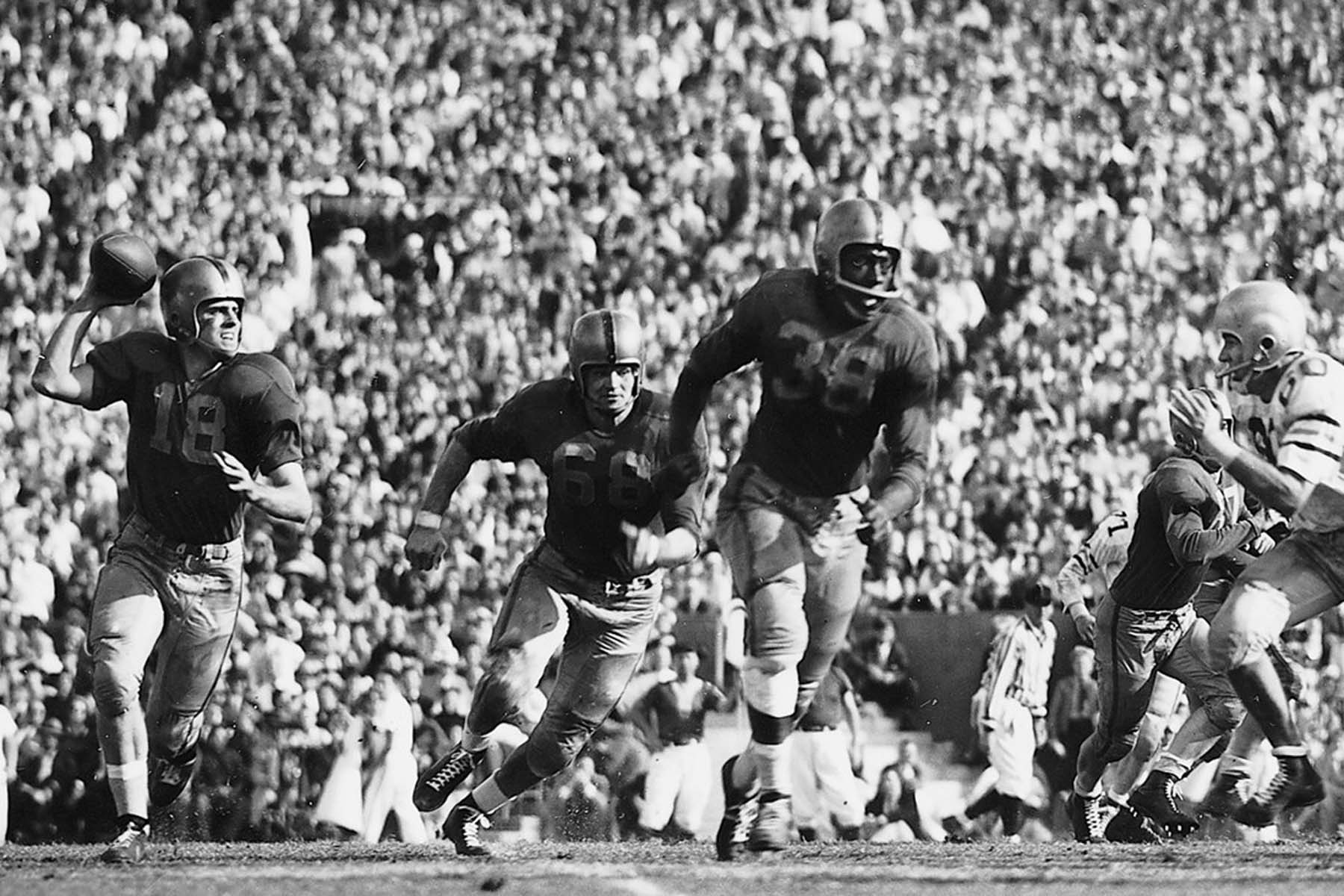 No other northern team was invited to the Sugar Bowl until nine years later when Syracuse made the trip. Times were changing and the Orange featured two black players (future NFL stars Floyd Little and Jim Nance) with little fanfare.
No other northern team was invited to the Sugar Bowl until nine years later when Syracuse made the trip. Times were changing and the Orange featured two black players (future NFL stars Floyd Little and Jim Nance) with little fanfare.
After college, Grier joined the Air Force and became a missile officer. Following his service, he was an administrator at a Pittsburgh community college
In 2009 Bobby was honored as a Washington High School Distinguished Citizen. Then in in 2019 he was inducted in the Sugar Bowl Hall of Fame.
Now, in August of this year, he will be added to the Massillon Wall of Champions. Congratulations, Bobby Grier.
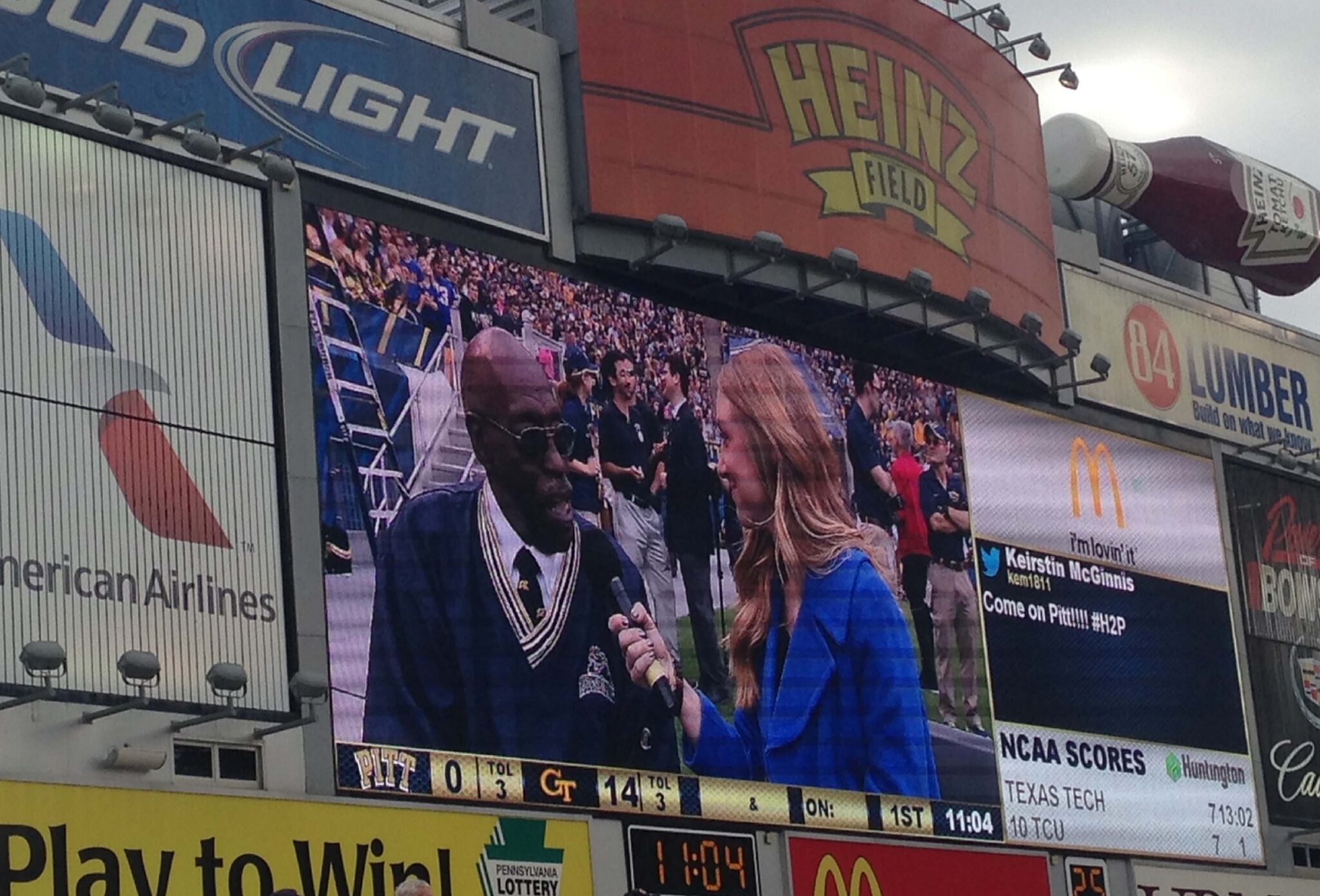
 History
History Chris Easterling, The Independent
Between Massillon and Pickerington Central, the teams had made a combined nine state semifinals and six title games over the last five years. That includes both teams reaching their respective championship games a year ago, the former in Division II and the latter in Division I.
So as both teams walked off the field after Pickerington Central’s 26-7 win, there was a sense of perspective from both sides. That perspective was simple: It’s not just about Week 1; it’s about 15 weeks.
“It’s just got to be process-driven” said Massillon coach Nate Moore, whose team was tied at 7-7 midway through the second quarter. “We’re a process-driven program. We prefer to have positive outcomes at the end of games, but we’re worried about the process. We have to move on from this fast. We want to have the best practice we’ve ever had on Monday.”
The words spoken by the orange-and-black clad Tigers was really no different from those spoken by the purple-and-white clad Tigers. That’s even after Pickerington Central ended the game on a 19-0 run and finished with a 343-135 edge in total yards.
Tyler Gillison, who gave Pickerington Central a 7-0 lead on a 20-yard touchdown catch on fourth down late in the first quarter, may have summed it up best. For the victors, it’s not about winning a game in Stark County in August, but winning one here in December.
“It gets us ready for the playoffs,” said Gillison, who had a key fumble recovery early in the fourth quarter as well. “Our first four games this year, they’re really going to test us this year. It’s just going to get us ready for the playoffs.”
For Massillon, the challenge was two-fold. Part of it was playing an ultra-talented Pickerington Central team that has at least a half-dozen Division I college recruits.
The other part was essentially breaking in 18 new starters on either side of the ball. Yet, for all of that relative inexperience, it was just a handful of plays on either side of the ball that separated it from a different outcome.
That was especially true of Massillon’s defense. It came up with a huge goal-line stand in the second quarter and, despite allowing 178 rushing yards to Orlando Kamara, limited Pickerington Central to just 2-of-12 on third-down conversions.
On offense, Massillon reached the other side of the 50 four times during the course of the evening. Its downfall proved to be a pair of fumbles lost, which led to 10 Pickerington Central points.
Massillon also was dropped for a safety on the second play after it stopped Pickerington Central at the goal line. That provided a 9-7 lead with 6:18 left in the first half.
“Our kids played hard, on both sides of the ball,” said Moore, whose team tied the game at 7-7 on Willtrell Hartson’s 1-yard run 59 seconds into the second quarter. “Our kids played hard. There’s some hitting going on out there, some great solo tackles. … A lot of flashes of really good football. Just not enough.”
Both teams started new quarterbacks: Darrius McElroy for Massillon and Braden Mantooth for Pickerington Central. McElroy provided some effective yards on the ground, netting 25 rushing yards despite having to handle multiple tough snaps.
Mantooth, meanwhile, threw for a pair of touchdowns as part of his 104-yard passing night. His 26-yard strike to Kobi Gorman on the final play of the third quarter opened up a 16-7 lead.
Mantooth also added a 1-yard fourth-quarter run. He ran for 27 yards.
“I felt really confident with him,” Pickerington Central coach Jay Sharrett said. “… In high school football, we didn’t fumble any quarterback-center exchanges. You take them for granted, but when you’re in a hard-hitting game like this, that’s the No. 1 thing. He made some good checks at the line and we’re 1-0.”
One game. One win for one team, one loss for the other. For both, though, nothing more and nothing less.
Reach Chris at chris.easterling@indeonline.com.
On Twitter: @ceasterlingINDE
 News
News  News
News Massillon vs. Pickerington Central
Massillon Head Coach: Nate Moore
Pickerington Central Head Coach: Jay Sherrett
Massillon’s recent success
Pickerington Central’s recent success
Massillon key players
Pickerington Central key players
Massillon offense
Massillon defense
Pickerington Central offense
Pickerington Central defense
Keys to success for Massillon
 News
News The first weekly Booster Club meeting will be held on Monday, August 23, at 7:00 pm at Eagles 190. The meeting is open to all who have purchased a Booster Club membership, which can be obtained at the door.
The first weekly Touchdown Club meeting will be held on Tuesday August 17, at 11:30 am at Eagles 190. The meeting is open to the general public for a seasonal fee of $25 and a weekly lunch fee of $10. The only exception is the Beat McKinley lunch, which costs $12. At the end of the season, the Touchdown Club presents the Bob Commings Memorial Hardnose Award to a deserving player on the basis of member votes that are tallied at the lunches.
Massillon Head Coach Nate Moore will speak at each meeting, often accompanied by several team co-captains. Game highlight films are narrated by the coach at the Booster Club meetings only.
 News
News Two of Ohio’s high school football powers knocked heads in Cincinnati on Thursday in the final tune-up before the start of the 2021 season. It was an abbreviated affair, most likely due to the 95-degree weather, with each team running two series of 10 plays each. But next week it gets serious, with the Tigers hosting 2020 Division 1 state finalist Pickerington Central and the Bombers facing Queen City contender Lakota West, a team Xavier beat last year in their regional finals, 10-7.
Massillon was the Division 2 state finalist in each of the past three years and currently holds a 31-game winning streak against public schools. St. Xavier, on the other hand, captured the Division 1 state championship last year. These two teams last met In 2005 at Fawcett Stadium to decide the D1 title, with X winning by a touchdown.
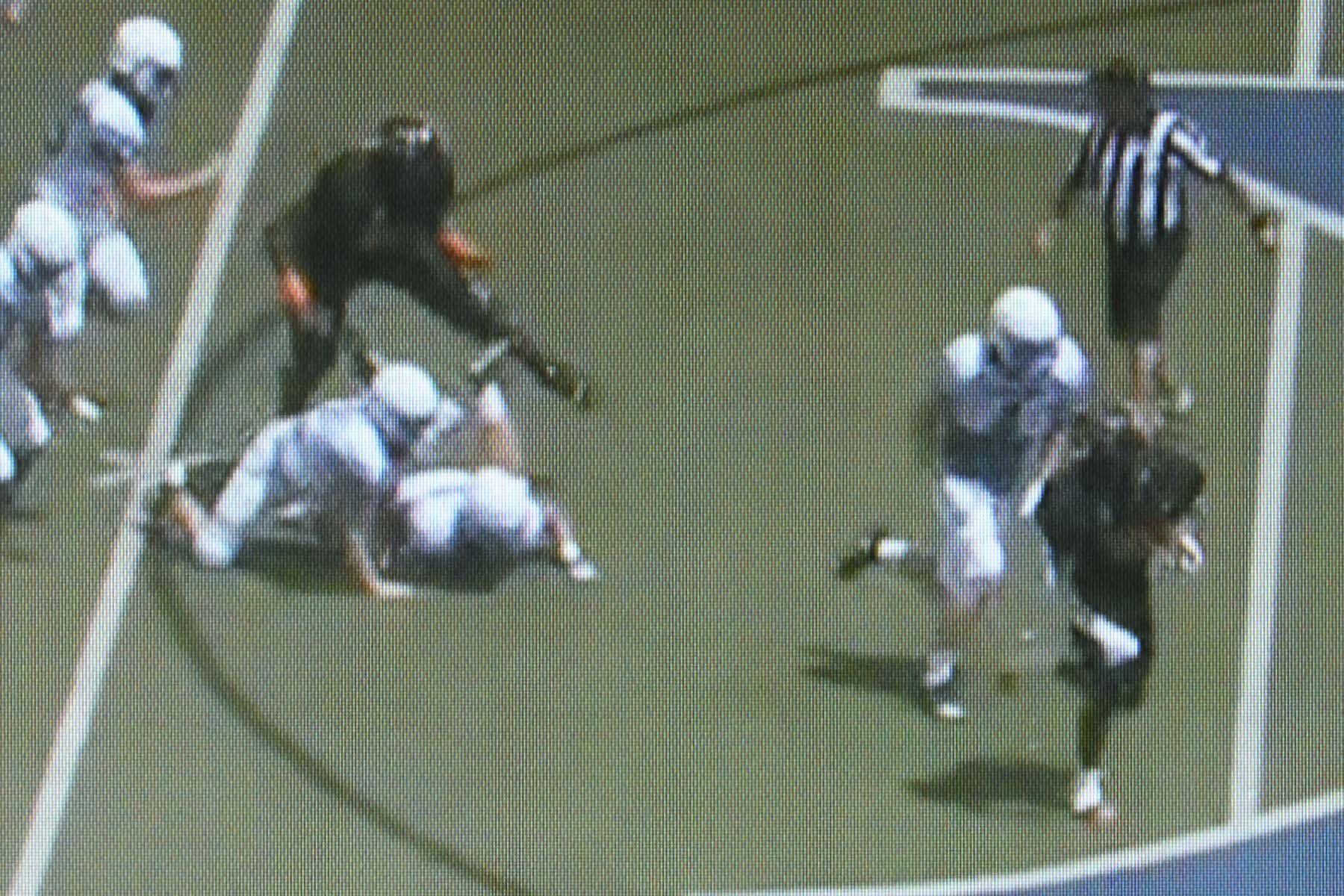
The Tiger offense took the field first, starting at their own 35 and advanced to their own 49 before being forced to punt. But the second try started off with a bang. Returning running back Willtrell Hartson, who showed flashes of brilliance throughout the second half of last year’s season, broke through the line on the first play for 50 yards and wasn’t caught on a shoestring tackle until he reached the Xavier 15. The next play netted just two yards and a second down pass fell incomplete. On third and eight the Tigers opted for a run, but gained just five yards. So they settled for a 25-yard field goal by freshman Nolan Hendricks.
St. X came right back with a 9-play, 48-yard drive that ended in a 27 field goal. The big play was a screen pass while the Tigers were in an all-out blitz that advanced the ball from the Massillon 32 to 12 yard line. But the Tigers stiffened at that point to force the kick.
Massillon’s third series ended after six plays with a punt from their own 49 and the final series ended at the Xavier 41 when they ran out of plays.
Meanwhile, Xavier drove to the Massillon 26, but also used up their allotment of ten plays.
Statistics wise, Massillon’s running backs gained 67 yards in 7 carries (9.6 ave.). Quarterback Darrius McElroy completed 2 of 6 passes for 27 yards and was sacked three times. Total yardage was 94.
St. Xavier’s backs gained 43 yards in 9 carries (4.8 ave.). Their quarterback completed 6 of 9 passes for 78 yards. Total yardage was 121.
On offense, Massillon struggled to get the running game going against the Bomber 3-3 odd stack defense, except for on Hartson’s long run. The passing game was a struggle with the receivers needing to fight through press coverage by the cornerbacks. In addition, for the second week in a row, the offensive line was unable to keep the defensive linemen and blitzers at bay, which prevented the quarterback from settling in to make good throws.
Defensively, the Tigers played very vanilla, with a cover-4 secondary against what is perhaps the most potent offense in the state. For example, last year St. X with their vaunted passing game put up 62 points on St. Ignatius the week after Massillon beat the Wildcats 21-14. With eight returning starters, including their quarterback and entire line, they run a fast-pace offense with multiple formations and plays, and looked the part of a polished team all day. Nevertheless, the Tigers held their own against this challenge.
Now Massillon must take what they have learned from these first two outings and improve on any obvious shortcomings. They can also now game-plan for specific opponents, something that wasn’t the case for the scrimmages.
Following the first team work, Massillon had a chance to run several plays using the second team offense. Freshmen quarterback Jalen Slaughter was one for four for 15 yards, including one sack. The run game produced 16 yards in 7 attempts.
The junior varsity was bested 14-7, with both teams scoring on long drives and St. Xavier also scoring on a long pass play.
The freshmen continue to show great potential as they defeated the Bombers 28-0.
 News
News It’s early, early in this new season and teams are just now learning what a football looks like. But that didn’t stop Massillon and Avon from getting together to knock heads, something they’ve been doing for several years now in a first scrimmage venue. This time Avon was the host.
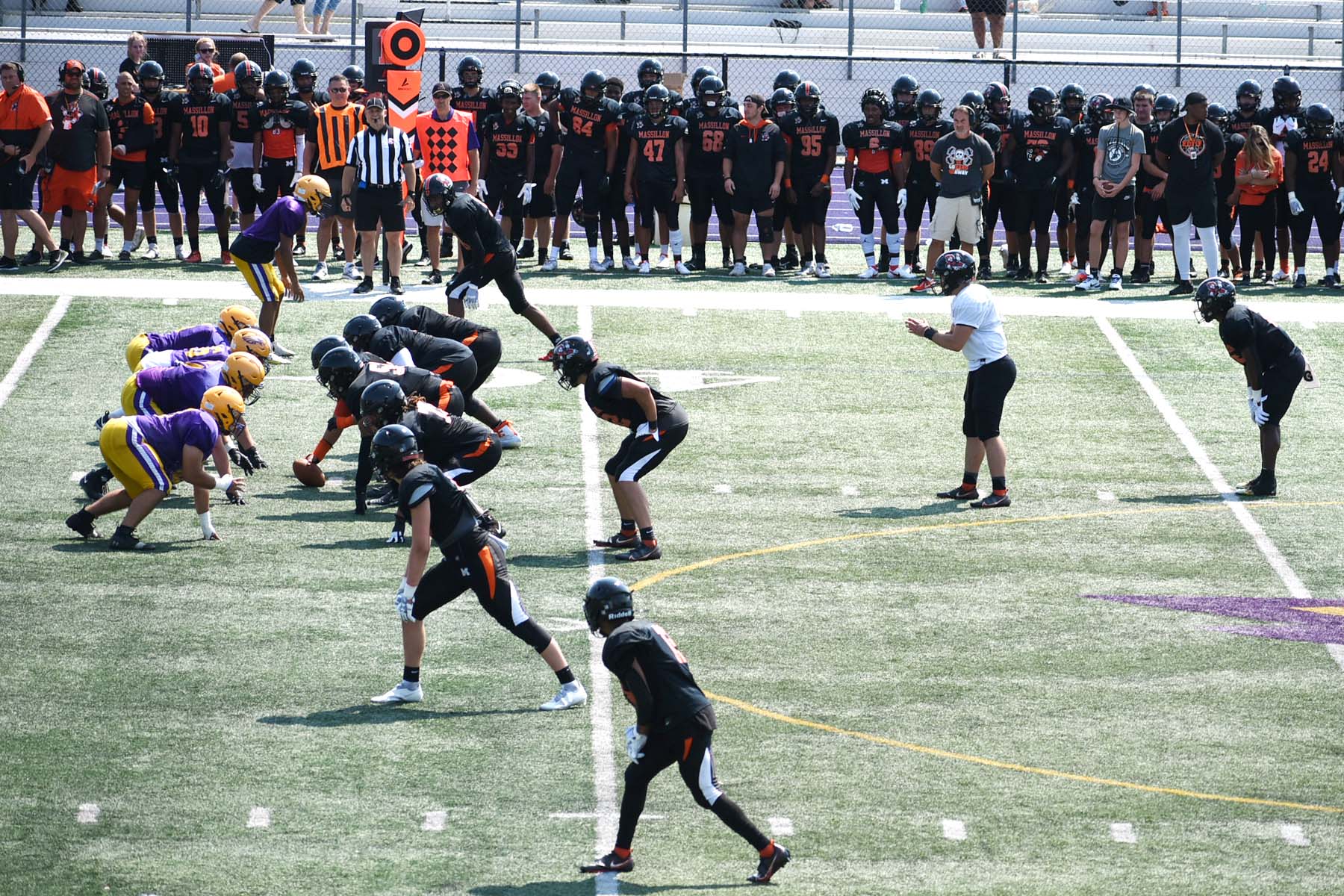
Both teams have achieved much success over the past few years, something that always bills this matchup as a good one. The Tigers have played in the Division 2 state finals in each of the past three years and the Eagles have won four straight regional titles in the same division. Therefore, this scrimmage gives head coaches Nate Moore and Mike Elder excellent first looks at their players against worthy opposition in order to figure out who their starters and backups will be.
The format for most of the scrimmage was such that each team ran ten plays, commencing at their own 25 yard line. If a fourth down play was called for, the team either punted or attempted a field goal and then returned to the 25 until the plays were exhausted. Throughout the affair both coaches mixed up their first and second units. The 3rd and 4th played later. Here’s a breakdown of the series for each team:
Massillon
Avon
Each team then ran one series starting at the opponent’s 40.
Massillon
Avon
Each team finished with a two series each starting at the opponent’s 20.
Massillon
Avon
Observations:
Next up is a Thursday scrimmage at Cincinnati St. Xavier, the 2020 Division 1 state champions. Start time is 2:00 pm.
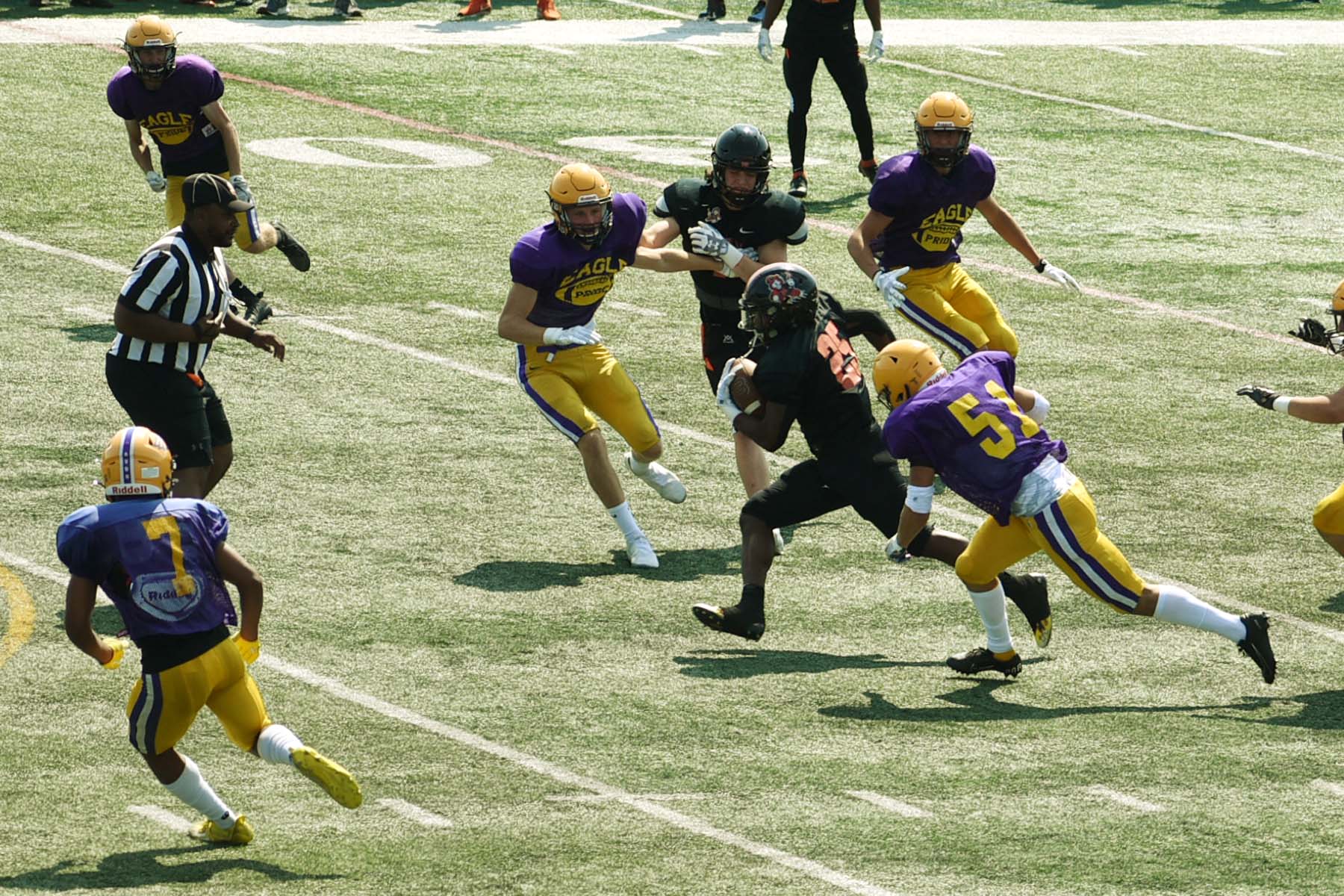
Willtrell Hartson sprints into the Avon secondary.
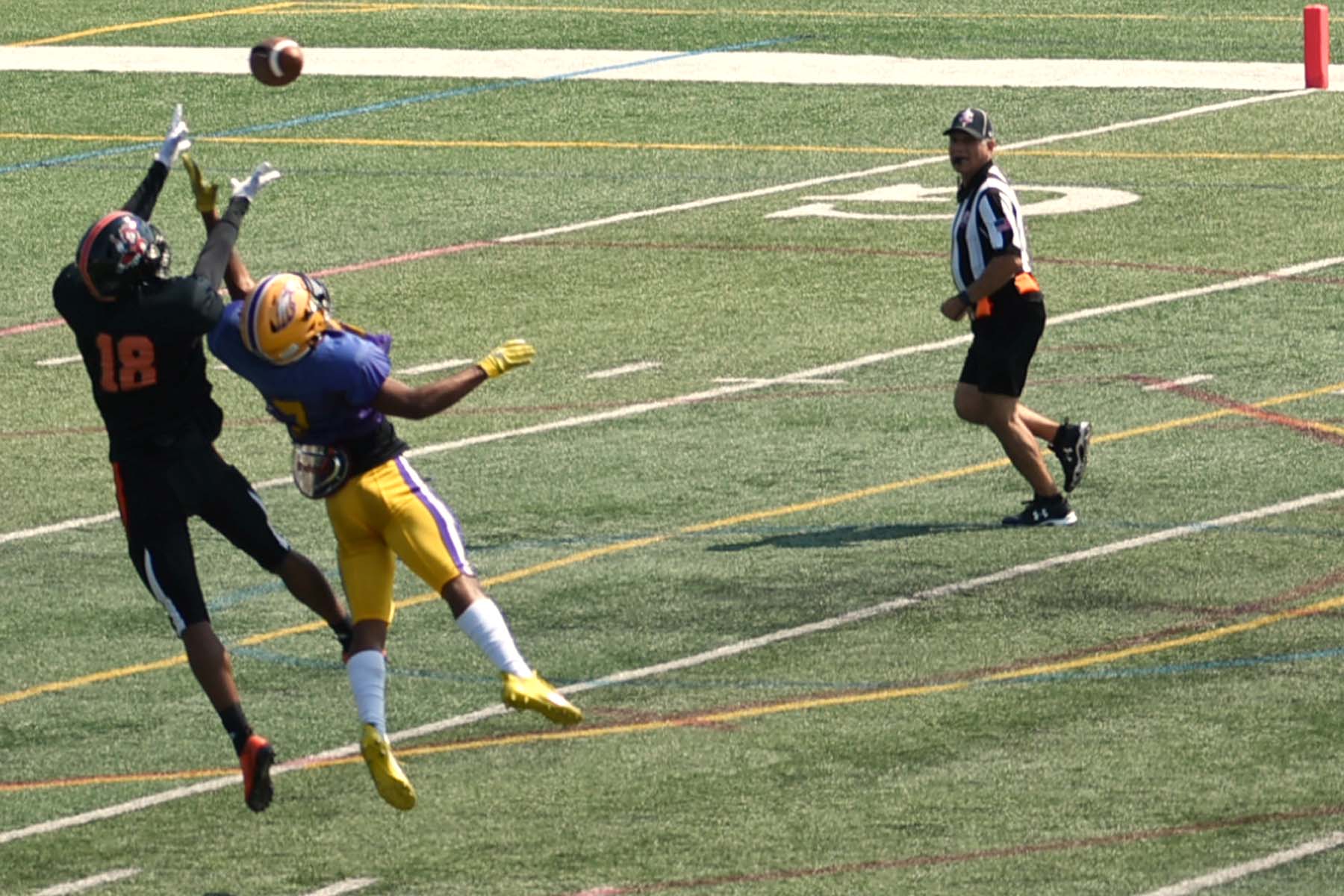
Ardell Banks goes high for the long pass against the Avon defender.

Quarterback Darrius McElroy lets loose from the pocket.
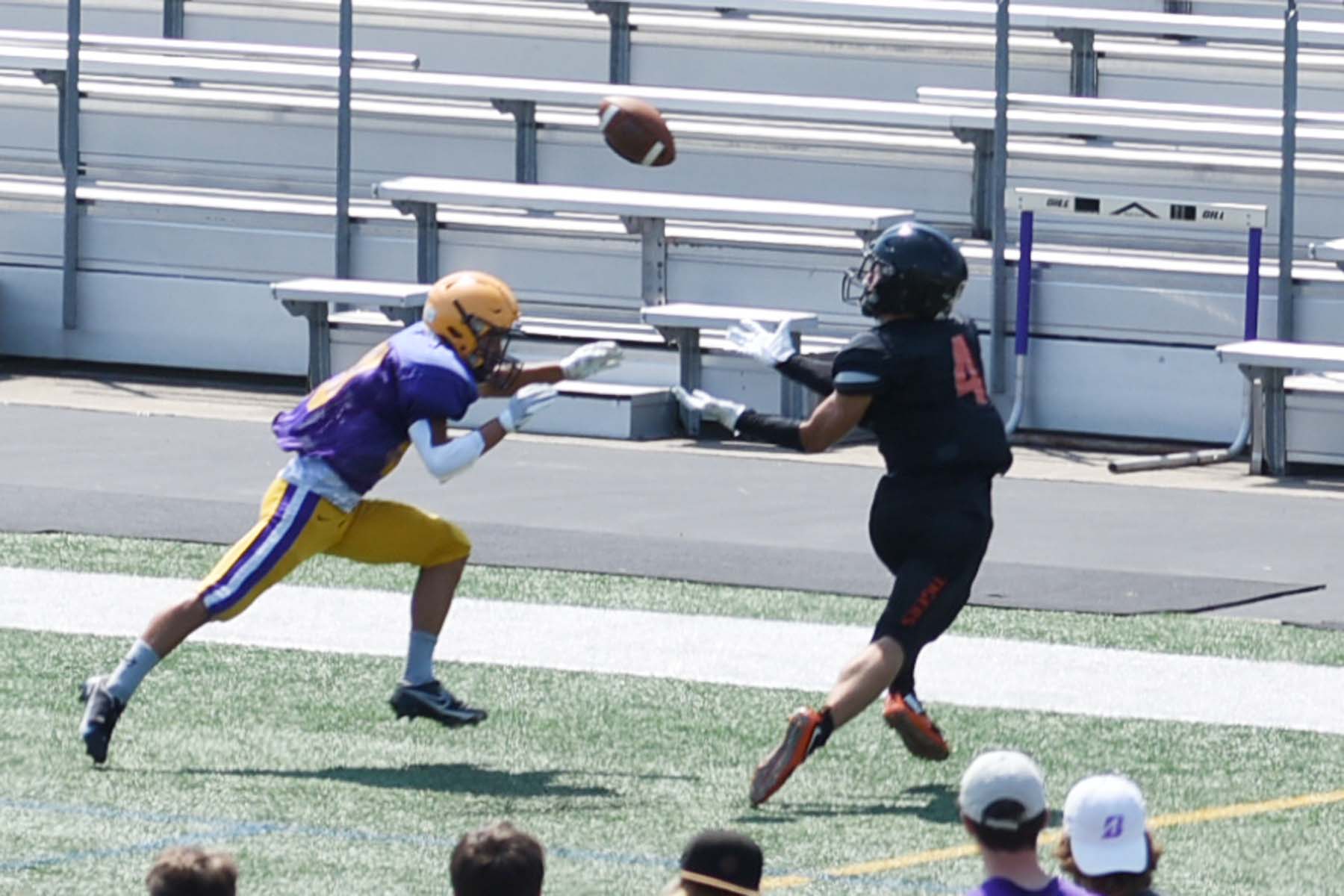
Austin Brawley completes a 14-yard touchdown pass from Jalen Slaughter.
 History
History It seems like summer just got here and already we are nearing the start of the 2021 high school football season. With the post-season playoffs being expanded this year, the date of the first regular season game has been pushed back yet another week, now at its earliest date in OHSAA history. So what’s going on this year? Here’s a quick look.
Massillon finished the regular season last year with a 5-1 record in a schedule that was shortened on account of the Covid-19 pandemic. With all of Ohio’s teams invited to the playoffs, the Tigers marched through their slated games, defeating 2019 state champ Cincinnati LaSalle in the state semifinals, before losing to Akron Hoban in the finals. It was Massillon’s third consecutive trip to the Division 2 state championship game. During that 3-year span, the Tigers compiled a record of 34-4. They also currently own a 31-game winning streak against their peers, the public schools.
Head Coach Nate Moore begins his 7th year at Massillon, following a brief stint at Cincinnati LaSalle, where he captured the Division 2 state championship. His overall record in Tigertown is 60-17 (.779), which includes five trips to the playoffs and a post-season mark of 16-5. His win total ranks third all-time behind Paul Brown (80) and Mike Currence (79). After a 4-6 start in 2015 as he was installing a new program, his record since has been 54-11 (.831).
Per the OHSAA, the official mandatory start of practice is August 1, although every team has been working out in some form since school let out in May. The OHSAA now sanctions team practices throughout the summer, replacing the previous 10-session limit.
A 5-day acclimatization period must be completed prior to contact, which consists of helmets only for two days, followed by helmets and shoulder pads for two days and finally all gear. The first two days may be completed in July. For Massillon, they have the week of July 26 off then begin in earnest on August 2 with shoulder pads on Monday and Tuesday, full gear on Wednesday and contact on Thursday. Friday is shoulder pads only as they prepare for their first scrimmage the next day.
Scrimmages are used to prepare a team for the season, giving coaches a chance to select their starters and fine tune their offenses and defenses. This year, teams are limited to two 3-hour scrimmages following the first day of full contact practice. As the number of official practice days and scrimmages has been reduced, it seems like teams have less and less time to prepare for the opener. That’s why a solid off-season program is so important now.
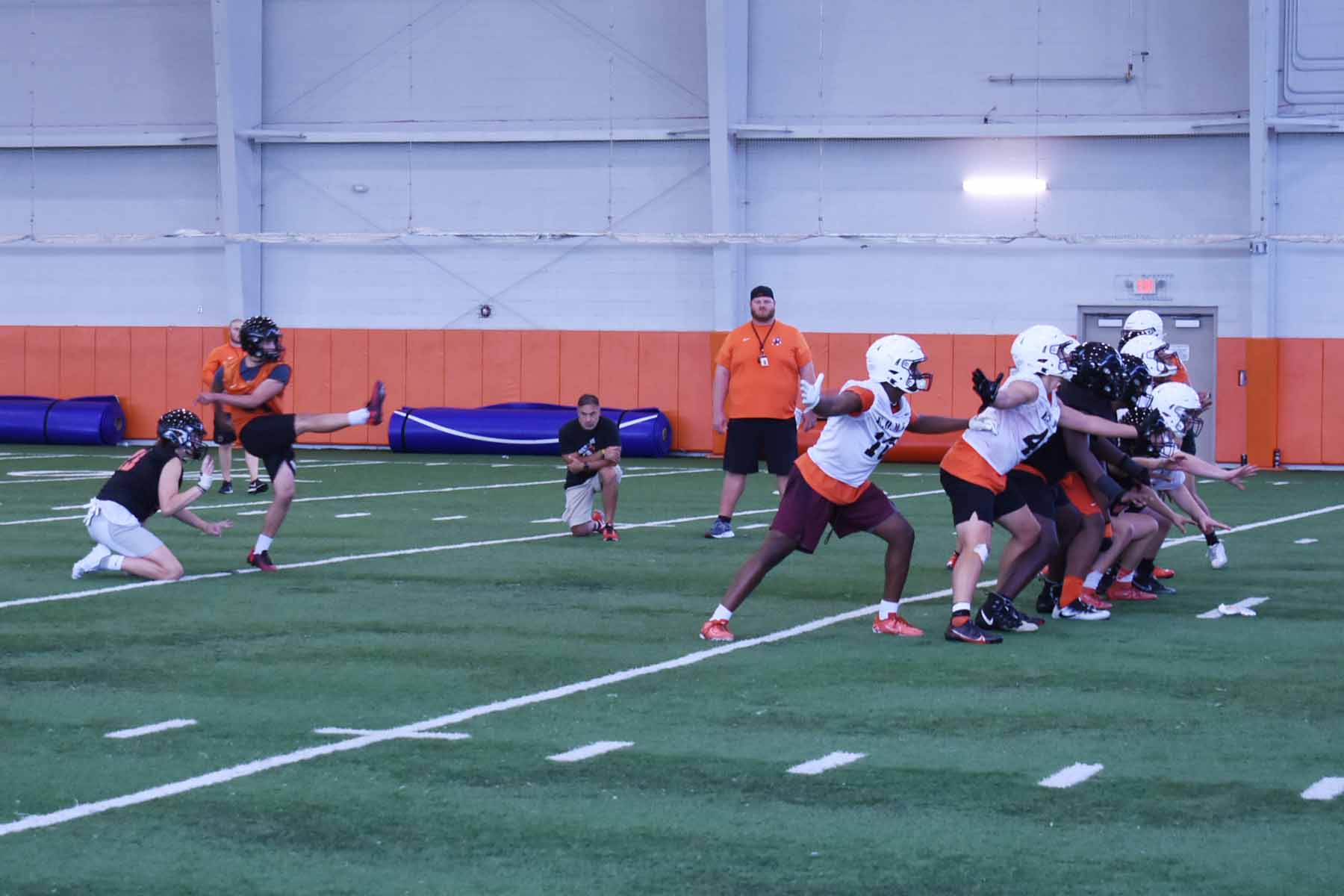 Coach Nate Moore’s charges will match up with a pair of top-notch programs that will give the Tigers excellent chances to expose their weaknesses and focus on correcting them before the season gets underway. The goal, of course, is maintaining a constant road of improvement throughout the regular season and then navigating successfully through the playoffs for another opportunity to compete for a state championship.
Coach Nate Moore’s charges will match up with a pair of top-notch programs that will give the Tigers excellent chances to expose their weaknesses and focus on correcting them before the season gets underway. The goal, of course, is maintaining a constant road of improvement throughout the regular season and then navigating successfully through the playoffs for another opportunity to compete for a state championship.
Massillon will travel to Avon on August 7 for an 11:30 am varsity scrimmage. The freshmen will compete against Avon at 9:00 am. Avon has won the Division 2, Region 6 title in each of the last four years and Coach Mike Elder’s group always provides excellent competition in this venue. On Thursday, August 12, the Tigers will be at Cincinnati St. Xavier. The freshmen and JV will face off at noon and varsity action will get underway at 2:00 pm. Last year the Bombers defeated Pickerington Central 44-3 in the Division 1 state finals and are expected to return a wealth of talent this year.
The regular season schedule is one of the better ones that Massillon has assembled, starting out with a bang against Pickerington Central, which is perhaps currently the best public school in Division 1. Also called the Tigers, they captured the D1 state title in both 2017 and 2019 and lost in the finals last year. Central currently owns a 21-game winning streak against public schools. Other top games this year include:
Aside from Pickerington Central, first time opponents this year are:
The playoffs will begin on October 29 and will be the first of six weeks of additional games, culminating in the state finals on December 2-4. Sixteen teams in each region will qualify, meaning that nearly every team in Division 1 and two-thirds of the teams in the other divisions will participate. Although football will last that much longer with the extended playoffs, the format does provide schools with opportunities to challenge themselves during the regular season with top-level opponents without jeopardizing playoff spots. For the 2021 season, Massillon will remain in Division 2, Region 7, along with the Columbus-area schools and a few local ones. In fact, there will be no regional assignment changes across the state this year as the OHSAA rebounds from last year’s Covid issues.
Expect to see many new faces in the Massillon lineup in 2021, as the Tigers graduated nearly every starter from last year’s team. Although this group is expected to be somewhat lacking across the board on varsity experience, it may still be senior-dominated while very talented. Look for more of a re-loading year than a re-building year as Moore’s charges become “program players.” The key to success then is the development of these new starters over the course of the season with goal of peaking when the playoffs commence. Below is a list of the more recognizable returnees and a couple new ones:
Look for the Tigers to attack much the same as the last few years. That is, with a run-heavy offense, utilizing a massive line that features both zone and power blocking, opening interior holes for Hartson and Beasley. Quarterback duties will be most likely be in the hands of senior Darrius McElroy, who has really developed in the off-season with both size and arm strength. He spent most of his time last year on the defensive side of the ball and on special teams. McElroy will be backed up by freshman Jalen Slaughter, who last year led his dominant 8th grade team to perfect 8-0 mark. The wide receiver group will be speedy, with Brawley leading the way.
Defensively, Massillon returns just Brawley. However, the coaches will not have any problem finding talented players to fill the open spots. Marcus Moore will fit quite nicely on the line as will Nathan DePuy at linebacker. Brawley will return to his safety position. Also, watch for backup junior Freddie Lenix to fill in well at corner. Kicking duties will fall to senior Shane Rue.
During the 2020 Covid-19 season, severe attendance restrictions were placed on the students and fans. For Massillon, they were limited to just 1500 and most fans were forced to watch the games from home on internet broadcasts. However, there will be no limit on spectators this year. So come on out and support your Tigers. It should be a great season and an exciting playoff run.
Mark these dates on your calendar:
Note to season ticket holders: Season ticket passes will not be mailed this year. They can be picked up at the Ticket Office starting August 3 or at the first game. No information is available at this time regarding tickets for away games.
 News
News Massillon residents are quite aware that athletics are a big deal at Washington High School, particularly when it comes to football, which owns 24 state and 9 national championships and is considered as an annual contender to win another. The tradition of the sport is lengthy, encompassing a time span of over 120 years, and many Tiger fans are eager to protect and maintain it. So what better place to demonstrate that to the public but in the athletic wing of the high school. There fans will have an opportunity to witness the ever growing displays that honor the great players and coaches of Massillon’s past.
The recent additions to the sports hall are just the start of what is envisioned to become a massive exhibit. It all started during the initial construction of the high school with traditional trophy cases. Next came the Wall of Champions with the large painted portraits of their inductees, later to be replaced by commemorative plaques. Then the Massillon Football Hall of Fame was born, with additional plaques for those honorees. Now, during the past few months, there have been two new additions. The first was display cases for a large collection of footballs that were actually used during some of Massillon’s big wins. And just recently, there hangs a massive Tiger flag that has a unique history of its own.
The Massillon Football Museum has been home to around fifty special footballs from past games, many dating back to the 1940s and 1950s. But until this year very few fans have had the opportunity to view them. Now, with the addition of several display cases, many of the balls can be viewed. And more balls will be included as display cases are added. The display cases have been installed in the hallway that connects the high school to the indoor facility.
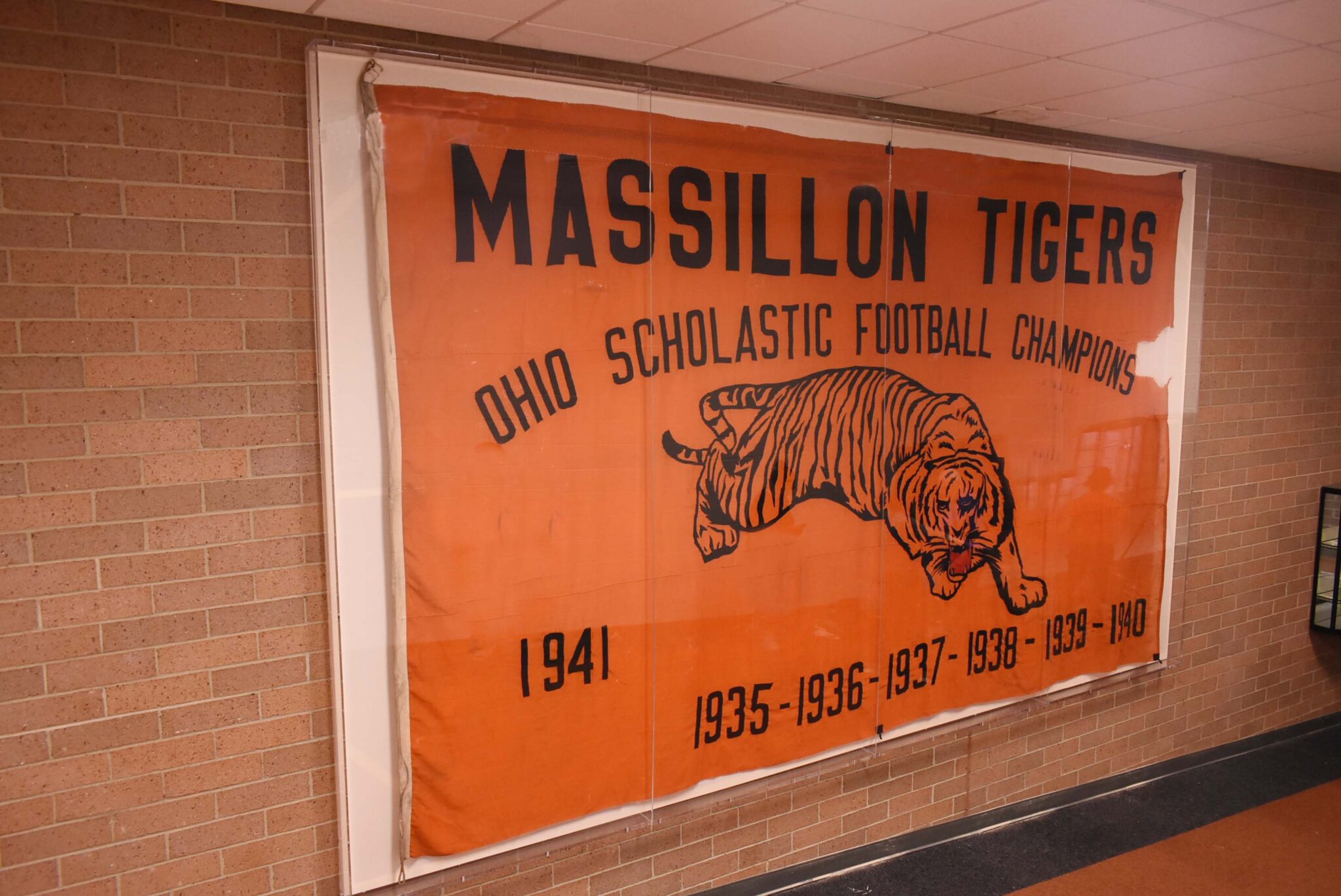
In 1938, during Paul Brown’s coaching tenure in Massillon, an avid fan constructed a 15’ x 8.5’ applique flag to celebrate Brown’s achievements. On the flag was stitched a running tiger and the years in which Brown won state championships, later adding the same award earned under Coach Bud Houghton. The last time the flag was seen was in 1942 when it flew from a flag pole during the Massillon-McKinley game, the day the Bulldogs snapped Massillon’s 52-game win streak. It was alleged that two former Canton players snatched the flag after the game and hid it in an attic in Canton. Later, Dr. David Leffler, a student at the time, informed police that after the flag was removed from the flag pole, it was ripped from his arms by a “Canton fan.” When the thievery went public, the deviant panicked and moved the flag to Youngstown, where it was eventually hung on the wall of a local lawyer. It took a long time to locate the flag, but in 1987 its whereabouts were finally discovered and the flag then promptly returned without penalty. Until recently it in hung in the basement of the old Massillon Post Office, which serves as the home of the Football Museum.
Through a tremendous effort of many volunteers and commercial organizations, the flag has been preserved and is now on display to the public for the first time in 79 years. Framed and behind a protective plexiglass cover, the flag can be viewed in the hallway that connects the high school to the indoor facility. Below is a list of the project participants:
All of this could not have been done without the backing of Mr. Dave Weaver, who has been instrumental through his vision and support throughout the construction of the sports hall. The installation of the football cases and flag are a continuation of his plan over the next few years to fill the hallway with sports displays. In fact he plans to expand next into the hall adjacent to the weight room. It is within this latter area that the Wall of Champion photos will be rehung. He also envisions a section honoring all Tiger football players that suited up professionally.
More good things to come. Be sure to stop by the next time you are in the high school.
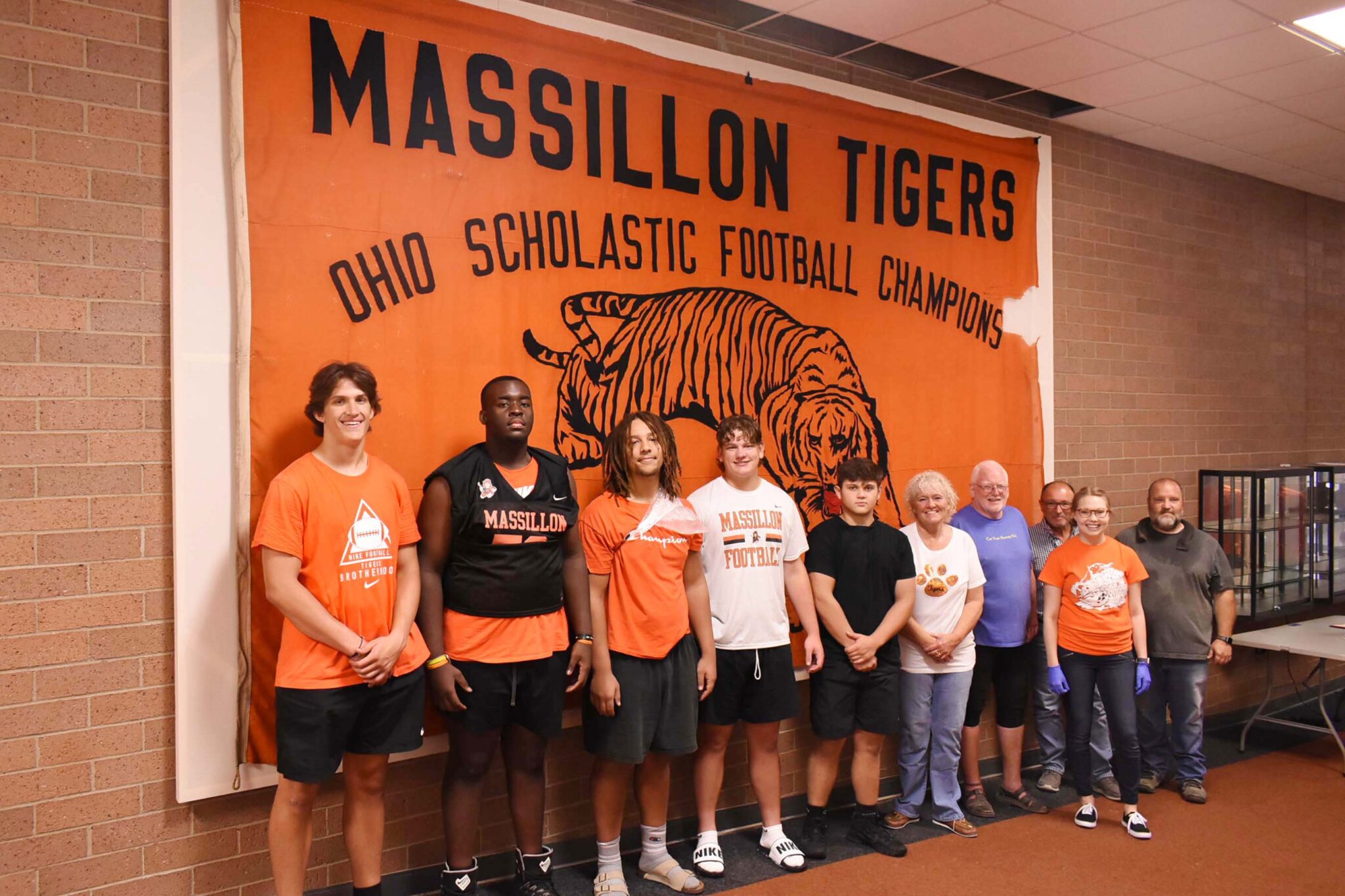
The crew in front of the finished product (Gift of Massillon Tiger Football Booster Club (2014.39.212) Collection of the Massillon Museum)
